LG Electronics USA L171N 17" Lcd monitor User Manual User s Manual H
LG Electronics USA 17" Lcd monitor User s Manual H
USERS MANUAL

EUT Type: 17” LCD Monitor
FCC ID: BEJL171N
Test Report No.: GETEC-E3-05-034
FCC Class B Certification
APPENDIX H
: USER’S MANUAL
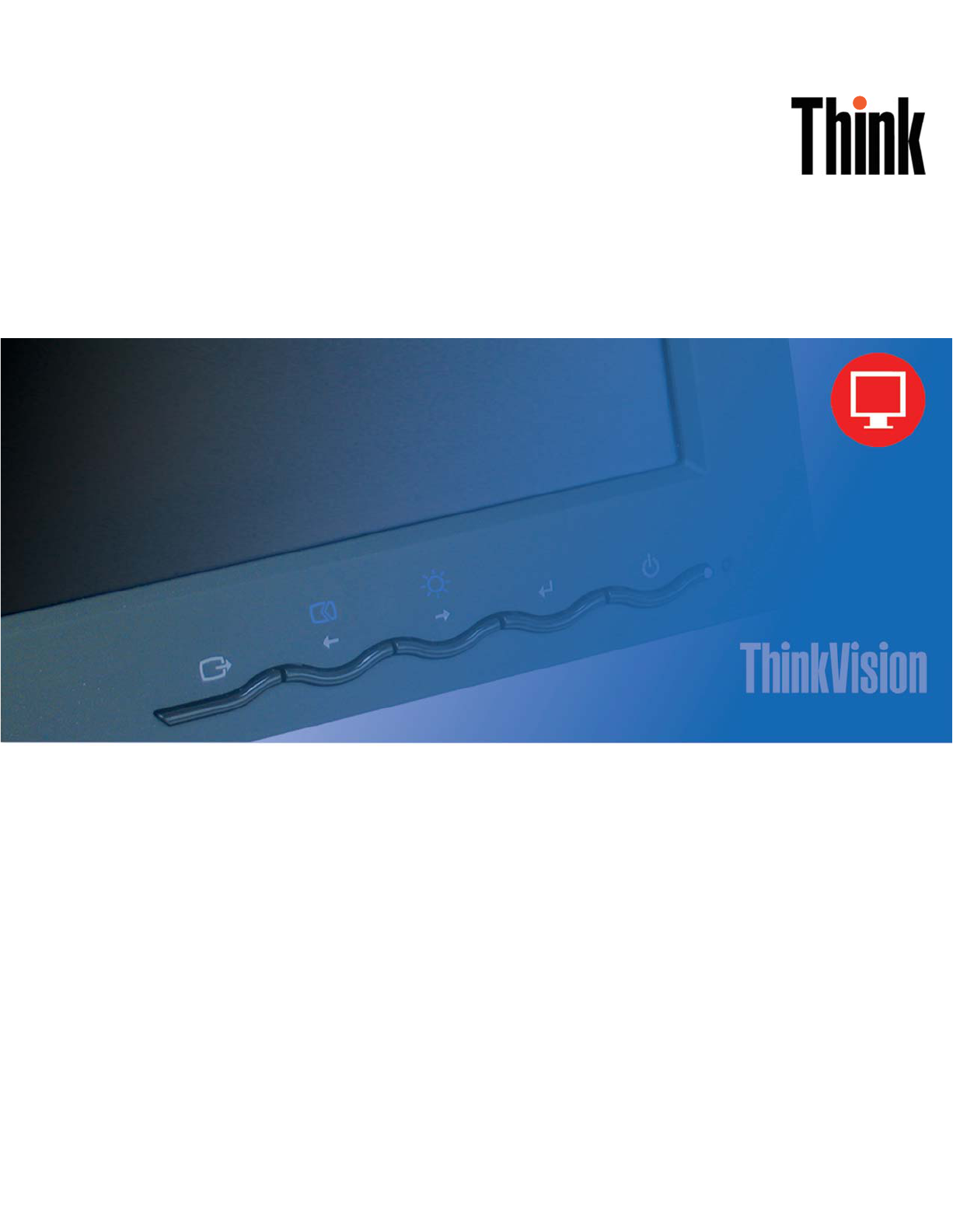
L171 Flat Panel Monitor
User’s Guide
Product numbers
9417-AB1
9417-AJ1
9417-AB7
9417-AB9
First Edition (April 2005)
© Copyright International Business Machines Corporation 2005. All rights reserved.
US Government Users Restricted Rights – Use, duplication or disclosure restricted by GSA ADP Schedule Contract
with IBM Corp.

Contents
Safety information . . . . . . . . . . . . . . . . . . . . . . . . . . . . . . .v
Chapter 1. Getting started . . . . . . . . . . . . . . . . . . . . . . . . . . . 1-1
Shipping contents . . . . . . . . . . . . . . . . . . . . . . . . . . . . . . . . . 1-1
Attaching the base and handling your monitor . . . . . . . . . . . . . . . . . . . . . . . 1-1
Product overview . . . . . . . . . . . . . . . . . . . . . . . . . . . . . . . . . 1-2
Types of adjustments . . . . . . . . . . . . . . . . . . . . . . . . . . . . . . . 1-2
User controls . . . . . . . . . . . . . . . . . . . . . . . . . . . . . . . . . 1-2
Cable lock slot . . . . . . . . . . . . . . . . . . . . . . . . . . . . . . . . . 1-3
Setting up your monitor . . . . . . . . . . . . . . . . . . . . . . . . . . . . . . . 1-3
Connecting and turning on your monitor . . . . . . . . . . . . . . . . . . . . . . . . 1-3
Registering your product . . . . . . . . . . . . . . . . . . . . . . . . . . . . . . 1-5
Chapter 2. Adjusting and using your monitor . . . . . . . . . . . . . . . . . . . 2-1
Comfort and accessibility . . . . . . . . . . . . . . . . . . . . . . . . . . . . . . 2-1
Arranging your work area . . . . . . . . . . . . . . . . . . . . . . . . . . . . . 2-1
Quick tips for healthy work habits . . . . . . . . . . . . . . . . . . . . . . . . . . 2-2
Accessibility information . . . . . . . . . . . . . . . . . . . . . . . . . . . . . . 2-2
Adjusting your monitor image . . . . . . . . . . . . . . . . . . . . . . . . . . . . . 2-3
Using the direct access controls . . . . . . . . . . . . . . . . . . . . . . . . . . . 2-3
Using the On-Screen Display (OSD) controls . . . . . . . . . . . . . . . . . . . . . . . 2-3
Selecting a supported display mode . . . . . . . . . . . . . . . . . . . . . . . . . . . 2-5
Understanding power management . . . . . . . . . . . . . . . . . . . . . . . . . . . 2-6
Caring for your monitor . . . . . . . . . . . . . . . . . . . . . . . . . . . . . . . 2-7
Detaching the monitor stand . . . . . . . . . . . . . . . . . . . . . . . . . . . . . 2-7
Chapter 3. Reference information . . . . . . . . . . . . . . . . . . . . . . . . 3-1
Monitor specifications . . . . . . . . . . . . . . . . . . . . . . . . . . . . . . . 3-1
Troubleshooting . . . . . . . . . . . . . . . . . . . . . . . . . . . . . . . . . . 3-2
Manual image setup . . . . . . . . . . . . . . . . . . . . . . . . . . . . . . . 3-3
Manually installing the monitor driver . . . . . . . . . . . . . . . . . . . . . . . . . 3-4
Service information . . . . . . . . . . . . . . . . . . . . . . . . . . . . . . . 3-6
Appendix A. Service and Support . . . . . . . . . . . . . . . . . . . . . . . . A-1
Online technical support . . . . . . . . . . . . . . . . . . . . . . . . . . . . . . A-1
Telephone technical support . . . . . . . . . . . . . . . . . . . . . . . . . . . . . A-1
Appendix B. Notices . . . . . . . . . . . . . . . . . . . . . . . . . . . . . B-1
Trademarks . . . . . . . . . . . . . . . . . . . . . . . . . . . . . . . . . . . B-2
© Copyright IBM Corp. 2005 iii
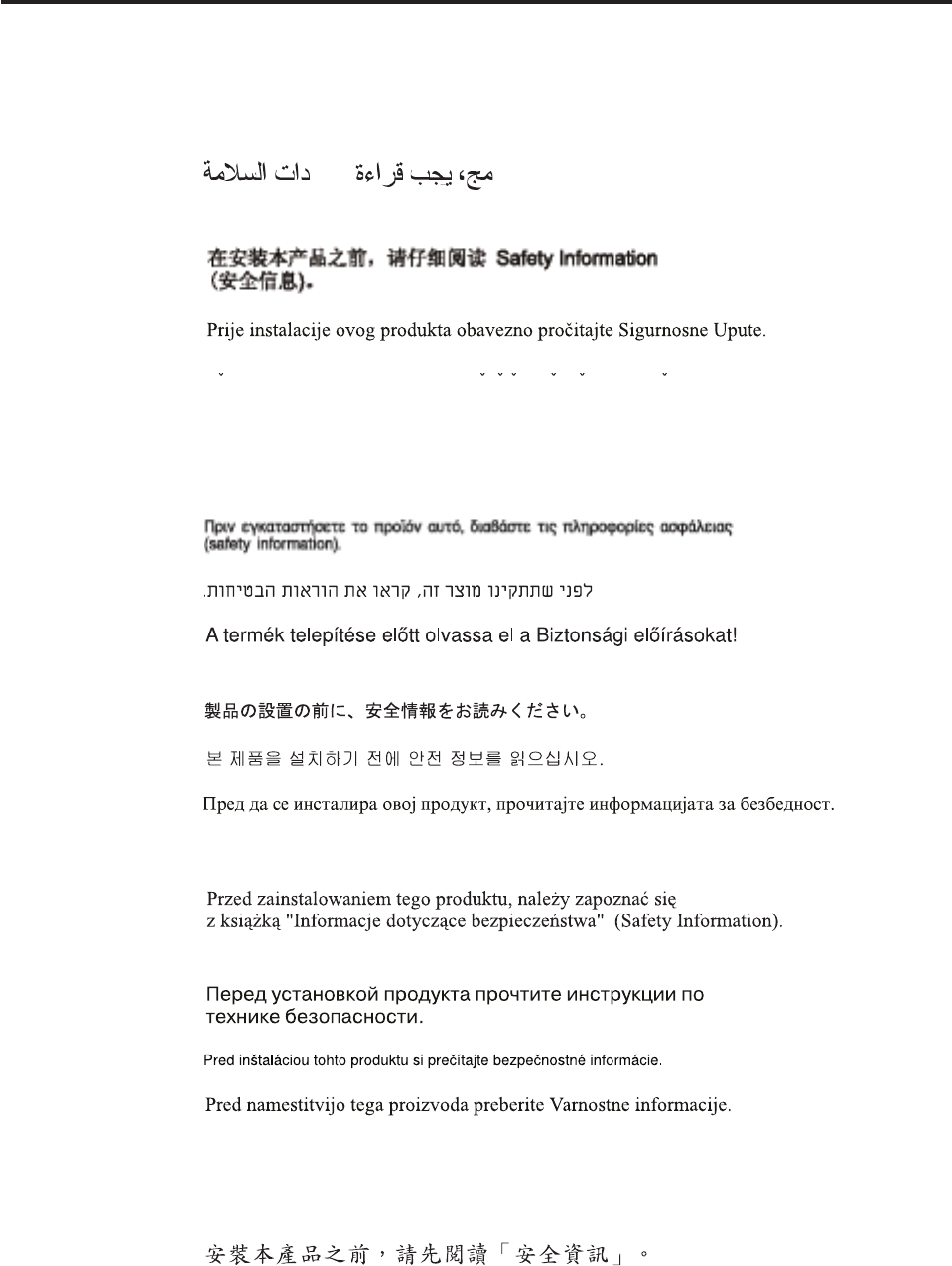
Safety information
Before installing this product, read the Safety Information.
Antes de instalar este produto, leia as Informações de Segurança.
Pred instalací tohoto produktu si prectete prírucku bezpecnostních instrukcí.
Læs sikkerhedsforskrifterne, før du installerer dette produkt.
Ennen kuin asennat tämän tuotteen, lue turvaohjeet kohdasta Safety Information.
Avant d’installer ce produit, lisez les consignes de sécurité.
Vor der Installation dieses Produkts die Sicherheitshinweise lesen.
Prima di installare questo prodotto, leggere le Informazioni sulla Sicurezza.
Lees voordat u dit product installeert eerst de veiligheidsvoorschriften.
Les sikkerhetsinformasjonen (Safety Information) før du installerer dette produktet.
Antes de instalar este produto, leia as Informações sobre Segurança.
Antes de instalar este producto lea la información de seguridad.
Läs säkerhetsinformationen innan du installerar den här produkten.
© Copyright IBM Corp. 2005 v
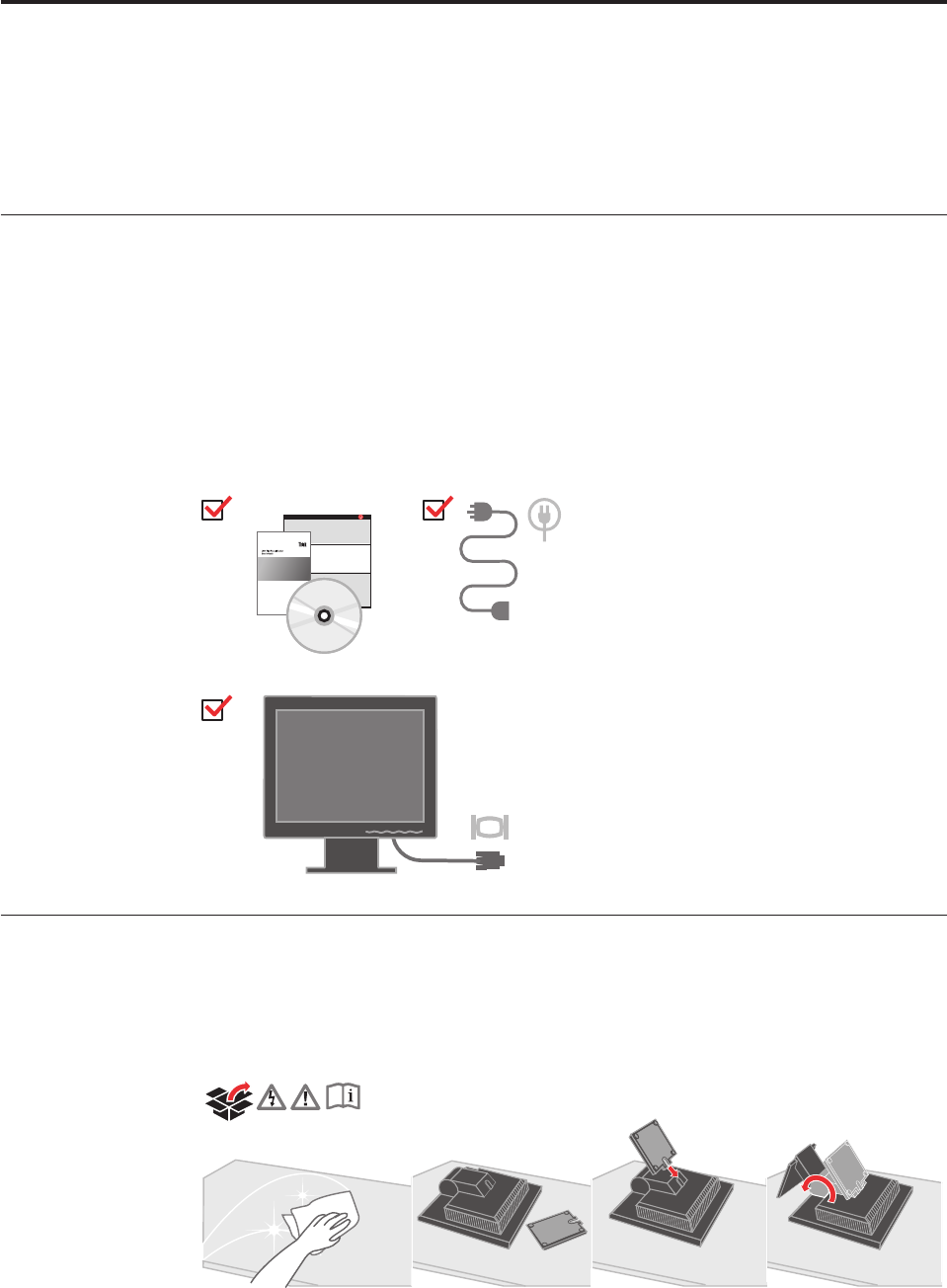
Chapter 1. Getting started
This User’s Guide contains detailed information on the ThinkVision
™
L171 Flat
Panel Monitor. For a quick overview, please see the Setup Poster that was shipped
with your monitor.
Shipping contents
The product package should include the following items:
v ThinkVision L171 Flat Panel Monitor Setup Poster
v Monitor Safety, Troubleshooting, and Warranty Guide
v Reference and Driver CD
v ThinkVision L171 Flat Panel Monitor
v Power Cord
v Analog Interface Cable- Attached to monitor
Attaching the base and handling your monitor
To set up your monitor, please see the illustrations below.
Note: Do not touch the monitor within the screen area. The screen area is glass
and can be damaged by rough handling or excessive pressure.
© Copyright IBM Corp. 2005 1-1
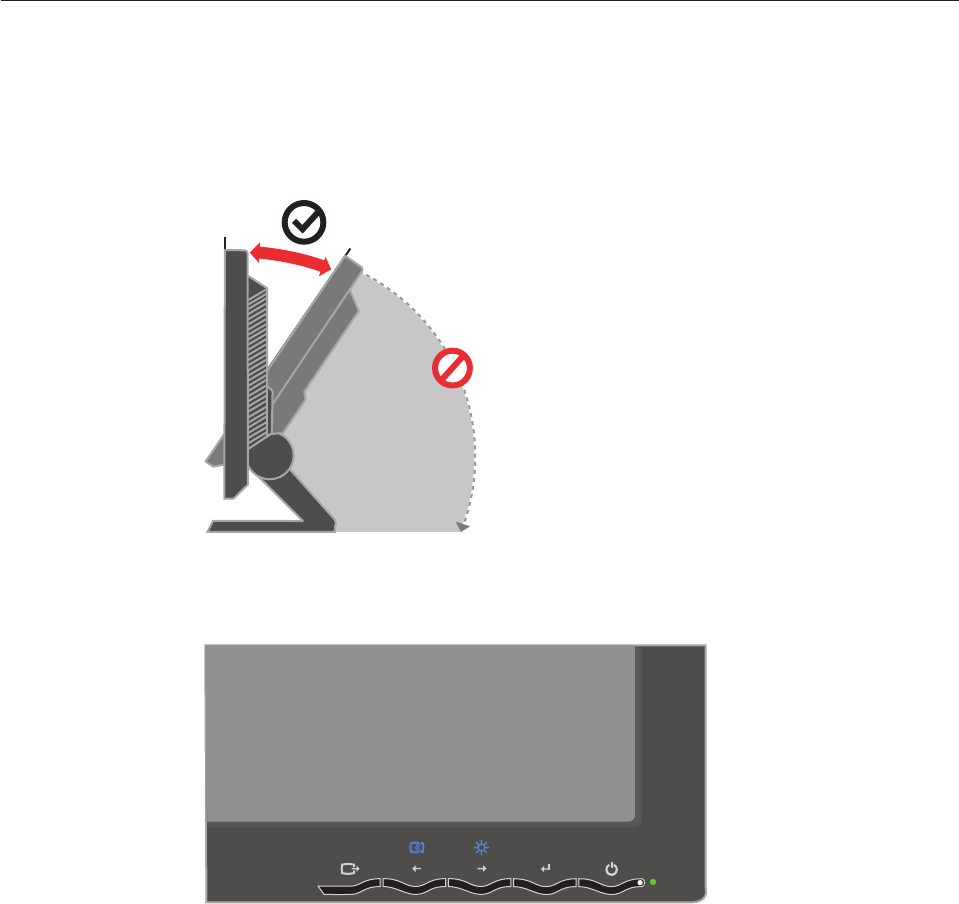
Note: To attach a VESA mount, please see “Detaching the monitor stand” on page
2-7.
Product overview
This section will provide information on adjusting monitor positions, setting user
controls, and using the cable lock slot.
Types of adjustments
Please see the illustration below for an example of the tilt range.
-4° 30°
User controls
Your monitor has controls on the front which are used to adjust the display.
For information on how to use these controls, please see “Adjusting your monitor
image” on page 2-3.
1-2 L171 Flat Panel Monitor User’s Guide
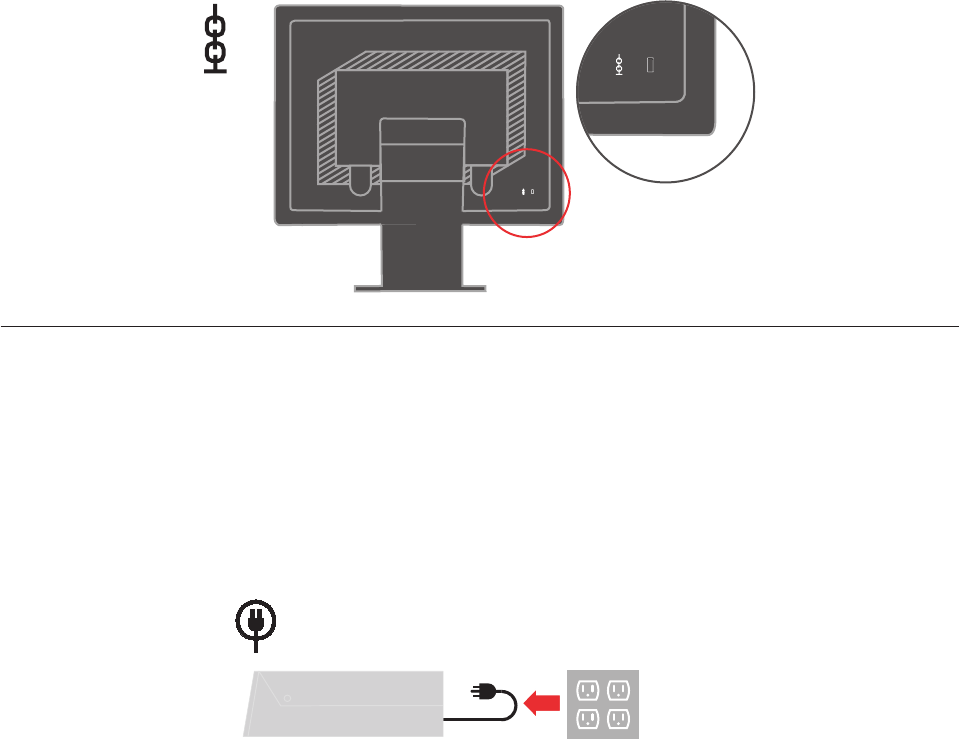
Cable lock slot
Your monitor is equipped with a cable lock slot located on the rear of your
monitor (in the lower right corner). Please see the instructions that came with the
cable lock to learn how to attach it.
Setting up your monitor
This section provides information to help you set up your monitor.
Connecting and turning on your monitor
Note: Be sure to read the Safety Information located in the Monitor Safety,
Troubleshooting, and Warranty Guide before carrying out this procedure.
1. Power off your computer and all attached devices, and unplug the computer
power cord.
Chapter 1. Getting started 1-3
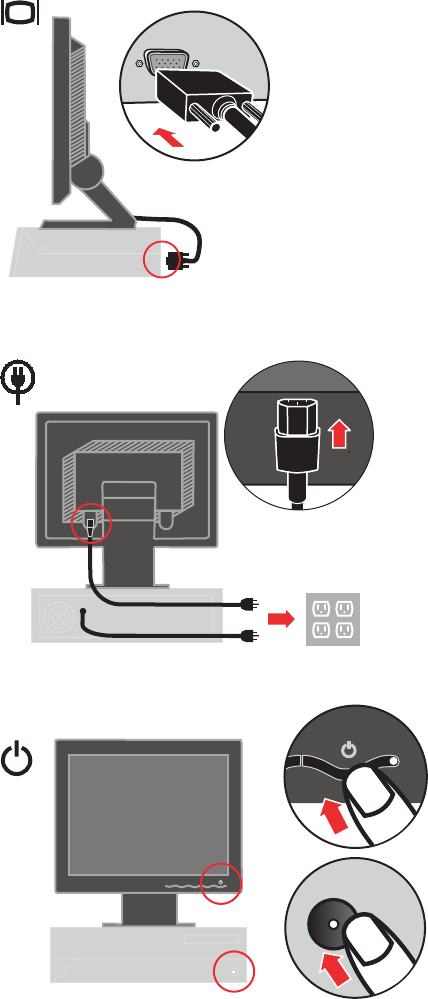
2. Connect the analog signal cable to the video port on the back of the computer.
Note: One end of the signal cable is already pre-attached to your monitor.
3. Insert the power cord into the monitor, then plug the monitor power cord and
the computer cord into grounded electrical outlets.
4. Power on the monitor and the computer.
1-4 L171 Flat Panel Monitor User’s Guide
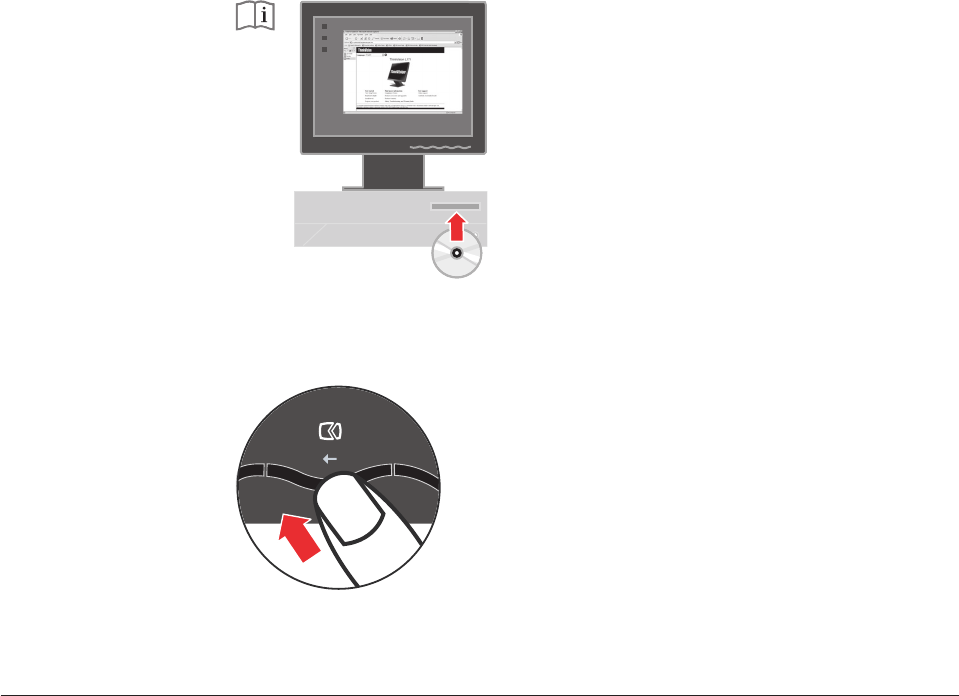
5. To install the monitor driver, insert the Reference and Driver CD, click Install
driver, and follow the on-screen instructions.
6. To optimize your monitor image, press the Automatic Image Setup key.
Automatic image setup requires that the monitor is warmed up for at least 15
minutes. This is not required for normal operation.
Note: If automatic image setup does not establish the image that you prefer,
perform manual image setup. See “Manual image setup” on page 3-3.
Registering your product
Please take a few moments to register your product and provide us with
information that will help IBM to better serve you in the future. Your feedback is
valuable to us in developing products and services that are important to you, as
well as in developing better ways to communicate with you. Register your option
on the IBM Web site at
http://www.ibm.com/pc/register/
IBM will send you information and updates on your registered product unless you
indicate on the Web site questionnaire that you do not want to receive further
information.
Chapter 1. Getting started 1-5

Chapter 2. Adjusting and using your monitor
This section will give you information on adjusting and using your monitor.
Comfort and accessibility
Good ergonomic practice is important to get the most from your personal
computer and to avoid discomfort. Arrange your workplace and the equipment
you use to suit your individual needs and the kind of work that you perform. In
addition, use healthy work habits to maximize your performance and comfort
while using your computer.
For more detailed information on any of these topics, visit the IBM Healthy
Computing Web site at: http://www.ibm.com/pc/ww/healthycomputing
Arranging your work area
Use a work surface of appropriate height and available working area to allow you
to work in comfort.
Organize your work area to match the way you use materials and equipment.
Keep your work area clean and clear for the materials that you typically use and
place the items that you use most frequently, such as the computer mouse or
telephone, within the easiest reach.
Equipment layout and setup play a large role in your working posture. The
following topics describe how to optimize equipment setup to achieve and
maintain good working posture.
Positioning and viewing your monitor
Position and adjust your computer monitor for comfortable viewing by considering
the following items:
v Viewing distance: Optimal viewing distances for monitors range from
approximately 510mm to 760mm (20 in to 30 in) and can vary depending on
ambient light and time of day. You can achieve different viewing distances by
repositioning your monitor or by modifying your posture or chair position. Use
a viewing distance that is most comfortable for you.
v Monitor height: Position the monitor so your head and neck are in a
comfortable and neutral (vertical, or upright) position. If your monitor does not
have height adjustments, you might have to place books or other sturdy objects
under the base of the monitor to achieve the desired height. A general guideline
is to position the monitor such that the top of the screen is at or slightly below
your eye-height when you are comfortably seated. However, be sure to optimize
your monitor height so the line of site between your eyes and the center the
monitor suits your preferences for visual distance and comfortable viewing
when your eye muscles are in a relaxed state.
v Tilt: Adjust the tilt of your monitor to optimize the appearance of the screen
content and to accommodate your preferred head and neck posture.
v General location: Position your monitor to avoid glare or reflections on the
screen from overhead lighting or nearby windows.
The following are some other tips for comfortable viewing of your monitor:
© Copyright IBM Corp. 2005 2-1
v Use adequate lighting for the type of work you are performing.
v Use the monitor brightness, contrast, and image adjustment controls, if
equipped, to optimize the image on your screen to meet your visual preferences.
v Keep your monitor screen clean so you can focus on the screen’s contents.
Any concentrated and sustained visual activity can be tiring for your eyes. Be sure
to periodically look away from your monitor screen and focus on a far object to
allow your eye muscles to relax. If you have questions on eye fatigue or visual
discomfort, consult a vision care specialist for advice.
Quick tips for healthy work habits
The following information is a summary of some important factors to consider to
help you remain comfortable and productive while you use your computer.
v Good posture starts with equipment setup: The layout of your work area and
the setup of your computer equipment have a large effect on your posture while
using your computer. Be sure to optimize the position and orientation of your
equipment by following the tips outlined in “Arranging your work area” on
page 2-1 so you can maintain a comfortable and productive posture. Also, be
sure to use the adjustment capabilities of your computer components and office
furniture to best suit your preferences now and as your preferences change over
time.
v Minor changes in posture can help avoid discomfort: The longer you sit and
work with your computer, the more important it is to observe your working
posture. Avoid assuming any one posture for an extended period of time.
Periodically make minor modifications in your posture to help deter any
discomforts that might arise. Make use of any adjustments that your office
furniture or equipment provide to accommodate changes in posture
v Short, periodic breaks help ensure healthy computing: Because computing is
primarily a static activity, it is particularly important to take short breaks from
your work. Periodically, stand up from your work area, stretch, walk for a drink
of water, or otherwise take a short break from using your computer. A short
break from work gives your body a welcome change in posture and helps to
ensure you remain comfortable and productive while you do work.
Accessibility information
IBM is committed to providing greater access to information and technology to
people with disabilities. With assistive technologies, users can access information in
the way most appropriate to their disability. Some of these technologies are already
provided in your operating system; others can be purchased through vendors or
accessed at: http://www.ibm.com/able/
2-2 L171 Flat Panel Monitor User’s Guide
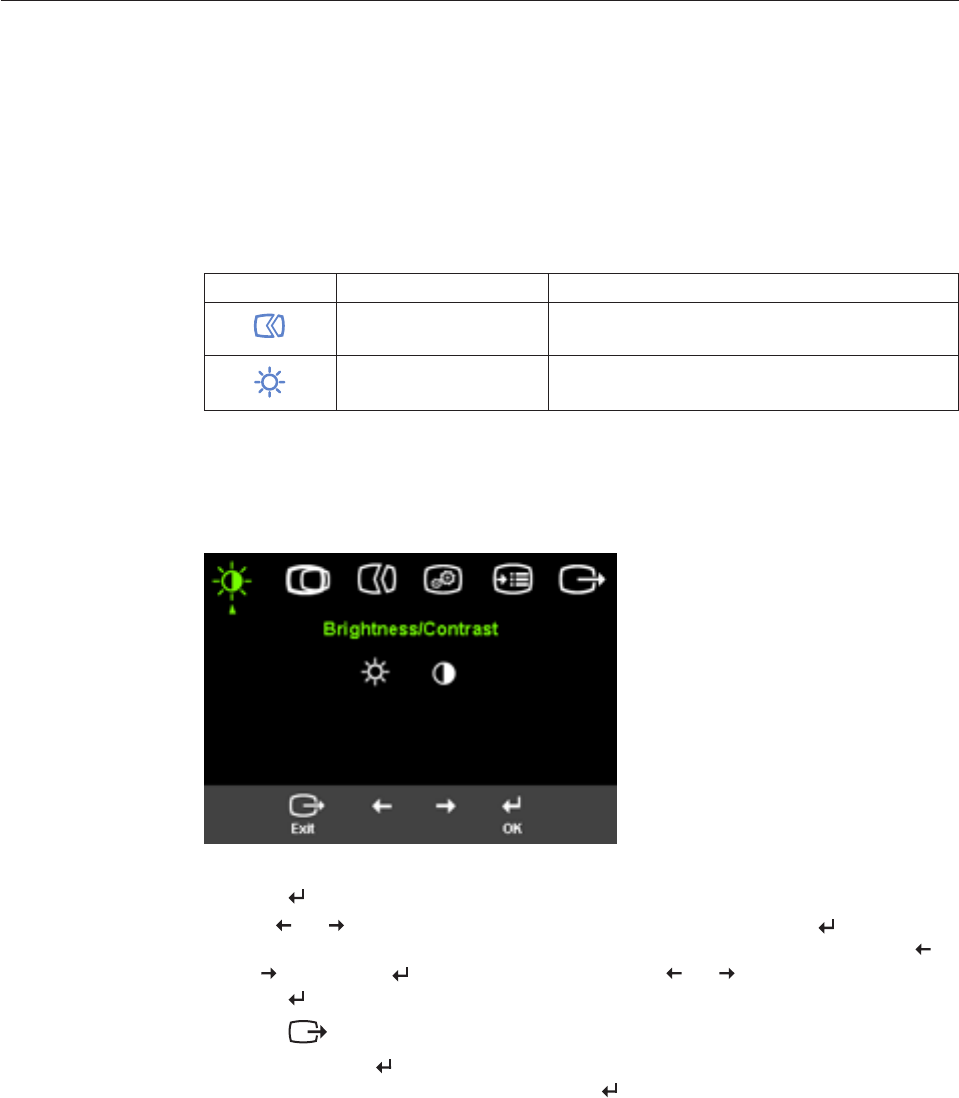
Adjusting your monitor image
This section describes the user control features used to adjust your monitor image.
Using the direct access controls
The direct access controls can be used when the On Screen Display (OSD) is not
displayed.
Note: The direct access controls are blue.
Table 2-1. Direct access controls
Icon Control Description
Image Setup Activates automatic image adjustment.
Brightness Direct access to Brightness adjustment.
Using the On-Screen Display (OSD) controls
The settings adjustable with the user controls are viewed through the On-Screen
Display (OSD), as shown below.
To use the controls:
1. Press
to open the main OSD menu.
2. Use
or
to move among the icons. Select an icon and press
to access
that function. If there is a sub-menu, you can move between options using
or
, then press
to select that function. Use
or
to make adjustments.
Press
to save.
3. Press
to move backwards through the sub-menus and exit from the OSD.
4. Press and hold
for 10 seconds to lock the OSD. This will prevent accidental
adjustments to the OSD. Press and hold
for 10 seconds to unlock the OSD
and allow adjustments to the OSD.
Chapter 2. Adjusting and using your monitor 2-3
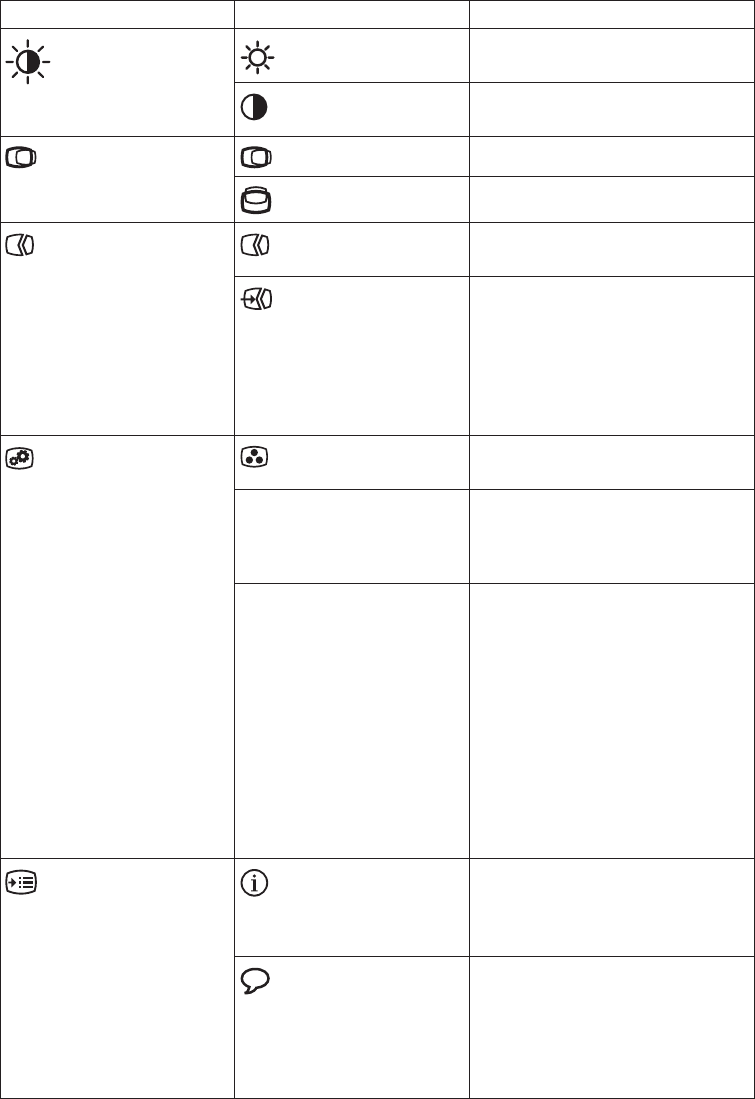
Table 2-2. OSD functions
OSD Icon on Main Menu Submenu Description
Brightness/Contrast
Brightness
Adjusts overall brightness
Contrast
Adjusts difference between light
and dark areas
Image Position
Horizontal Position
Moves the image left or right.
Vertical Position
Moves the image up or down.
Image Setup
Automatic
Automatically optimizes the
image.
Manual
Manually optimizes the image.
See “Manual image setup” on
page 3-3.
v Clock
v Phase
v Save
Image Properties
Color
Adjusts intensity of red, green,
and blue.
Preset mode v Default
v Reddish
v Bluish
Custom v Red: Increases or decreases the
saturation of ’red’ in the
image.
v Green: Increases or decreases
the saturation of ’green’ in the
image.
v Blue: Increases or decreases the
saturation of ’blue’ in the
image.
v Save: Saves the custom color
choices.
Options
Information
Shows resolution, refresh rate,
and product details.
Note: This screen does not allow
any changes to the settings.
Language
This section lists the languages
supported by your monitor.
Note: The language chosen only
affects the language of the OSD.
It has no effect on any software
running on the computer.
2-4 L171 Flat Panel Monitor User’s Guide
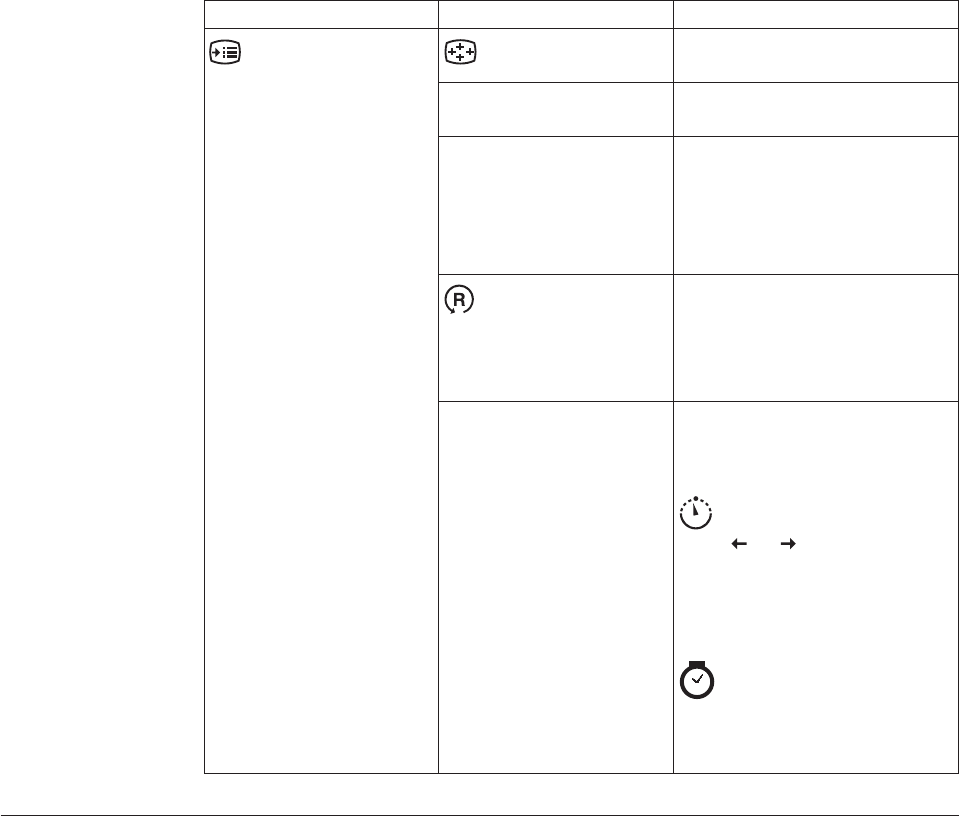
Table 2-2. OSD functions (continued)
OSD Icon on Main Menu Submenu Description
Options
Menu Position
Menu position adjusts menu
location on the screen.
Default Default returns the menu
position to the default settings.
Custom v Horizontal: Changes the
horizontal position of the OSD.
v Vertical: Changes the vertical
position of the OSD.
v Save
Factory Reset
v Cancel
v Reset
Resets monitor to the original
factory settings.
Accessibility Controls button and menu
settings for accessibility
preferences.
Button repeat rate:
Select
or
to change.
v Off
v Default
v Slow
Menu time out: Sets the
length of time the OSD will
remain active after the last time a
button is pressed.
Selecting a supported display mode
The display mode the monitor uses is controlled by the computer. Therefore, refer
to your computer documentation for details on how to change display modes.
The image size, position and shape might change when the display mode changes.
This is normal and the image can be readjusted using automatic image setup and
the image controls.
Unlike CRT monitors, which require a high refresh rate to minimize flicker, LCD or
Flat Panel technology is inherently flicker-free.
Note: If your system has previously been used with a CRT monitor and is
currently configured to a display mode outside the range of this monitor, you may
need to re-attach the CRT monitor temporarily until you have re-configured the
system; preferably to 1280 x 1024 at 60 Hz, which is the Native Resolution Display
mode.
Chapter 2. Adjusting and using your monitor 2-5
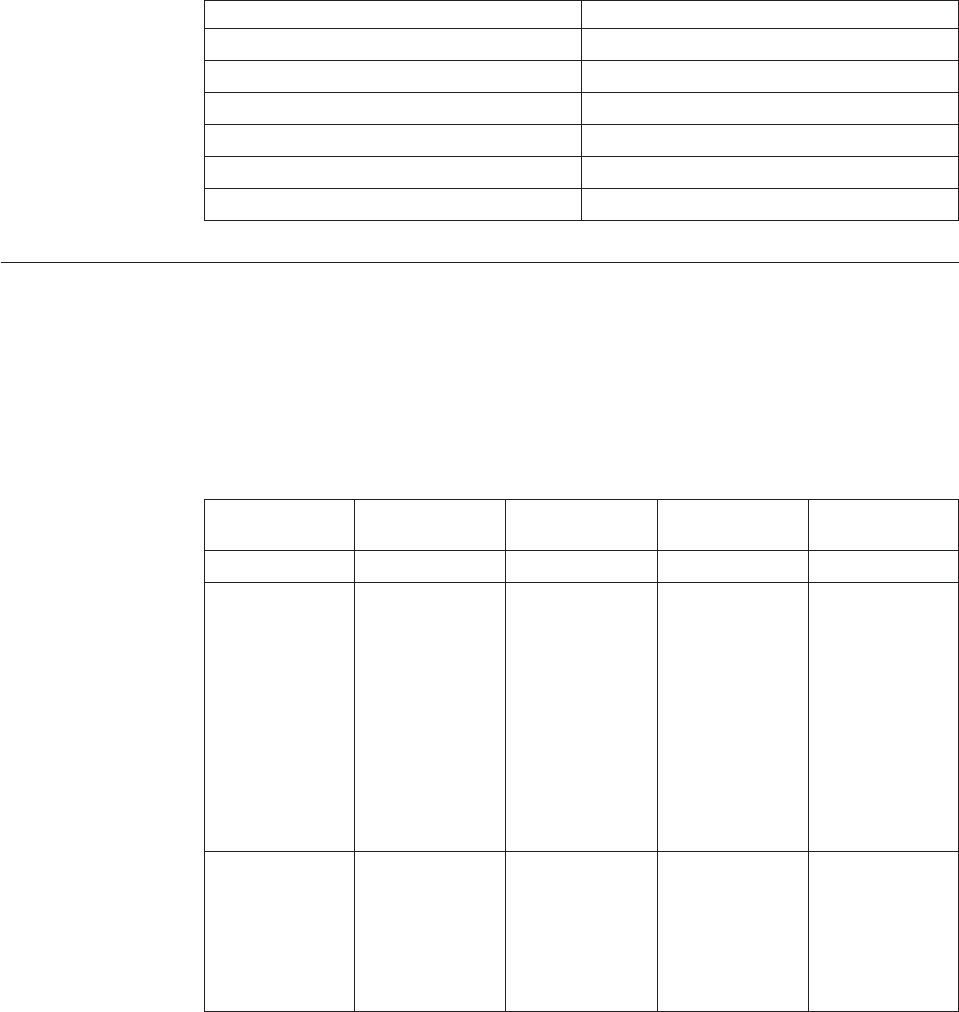
The display modes shown below have been optimized at the factory.
Table 2-3. Factory set display modes
Addressability Refresh rate
640 x 350 70 Hz
640 x 480 60 Hz, 67 Hz, 72 Hz, 75 Hz
720 x 400 70 Hz
800 x 600 60 Hz, 72 Hz, 75 Hz
1024 x 768 60 Hz, 70 Hz, 75 Hz
1280 x 1024 60 Hz, 70 Hz, 75 Hz
Understanding power management
Power management is invoked when the computer recognizes that you have not
used your mouse or keyboard for a user-definable period. There are several states
as described in the table below.
For optimal performance, switch off your monitor at the end of each working day,
or whenever you expect to leave it unused for long periods during the day.
Table 2-4. Power indicator
State Power Indicator Screen
Restoring
Operation Compliance
On Steady green Normal
Standby/Suspend Steady amber
Flashing green
(model AB7)
Blank Press a key or
move the mouse
There may be a
slight delay
before the image
reappears.
Note: Standby
also occurs if
there is no
image output to
the monitor.
ENERGY STAR
Off Off Blank Press a key or
move the mouse
There may be a
slight delay
before the image
reappears.
ENERGY STAR
2-6 L171 Flat Panel Monitor User’s Guide
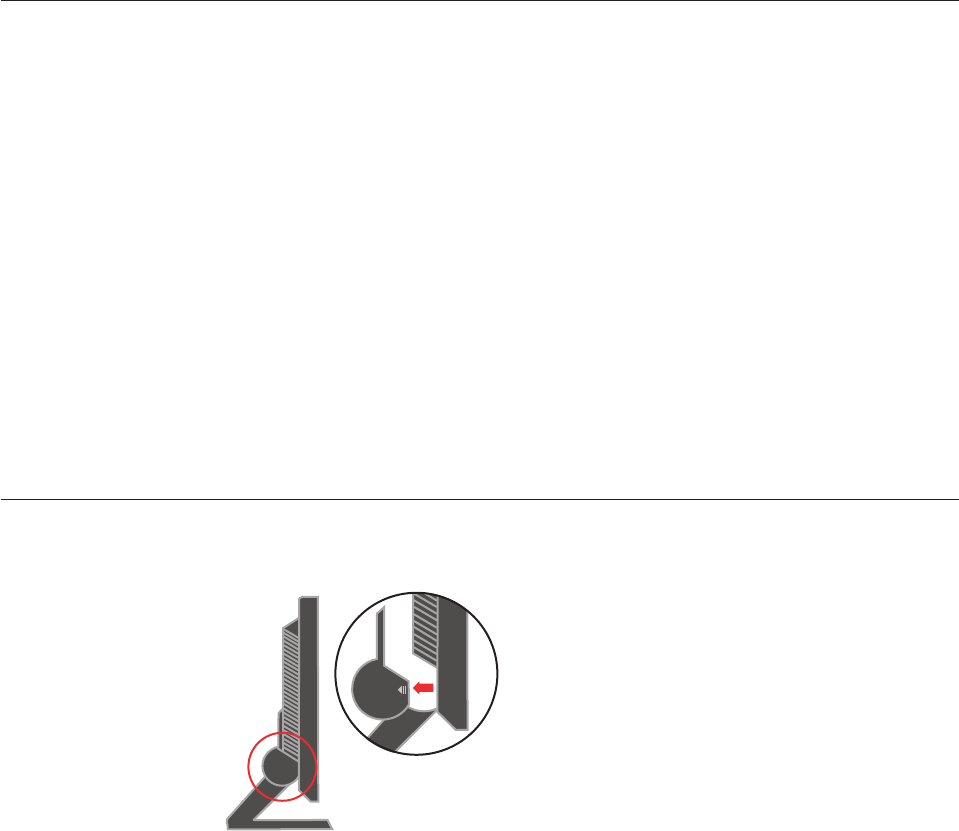
Caring for your monitor
Be sure to turn off the power before you perform any maintenance on the monitor.
Do not:
v Apply water or liquid directly to your monitor.
v Use solvents or abrasives.
v Use flammable cleaning materials to clean your monitor or any other electrical
equipment.
v Touch the screen area of your monitor with sharp or abrasive items. This type of
contact may cause permanent damage to your screen.
v Use any cleaner which contains an anti-static solution or similar additives. This
may harm the coating of the screen area.
Do:
v Lightly dampen a soft cloth with water and use this to gently wipe the covers
and the screen.
v Remove grease or finger marks with a damp cloth and a little mild detergent.
Detaching the monitor stand
Gently squeeze both ends of the cylinder and remove in the direction shown.
This allows access to the screws that attach the stand to the monitor.
Chapter 2. Adjusting and using your monitor 2-7
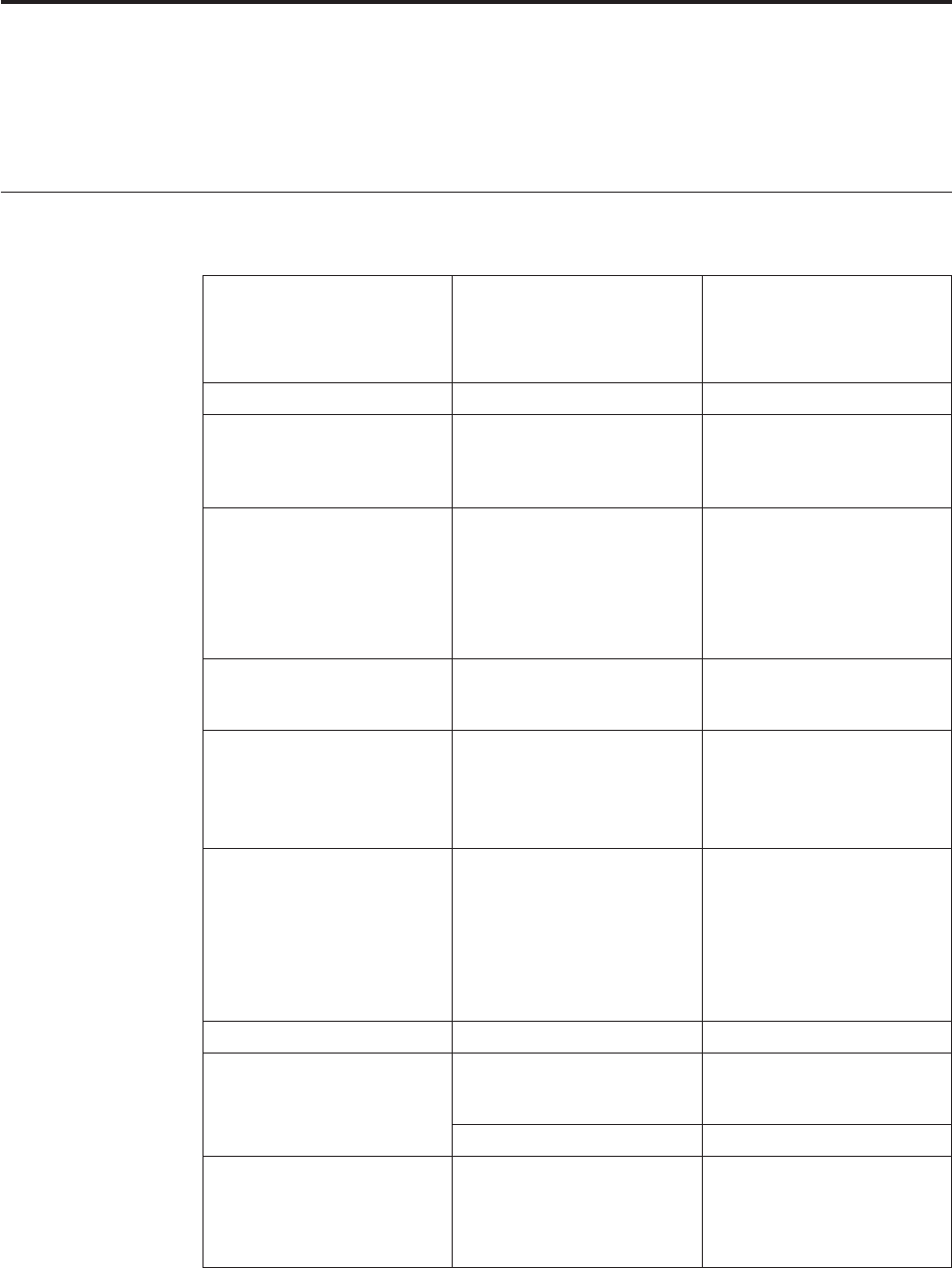
Chapter 3. Reference information
This section contains monitor specifications, instructions to manually install the
monitor driver, troubleshooting information, and service information.
Monitor specifications
Table 3-1. Monitor specifications for type-model 9417-Axx
Dimensions Height
Depth
Width
383.5 mm (15.1 in.)
169.9 mm (6.9 in.)
367.5 mm (14.5 in.)
Stand Tilt range -4°/+30°
VESA mount Supported 100 mm (3.94 in.)
IBM radial arm sold
separately.
Image Viewable image size
Maximum height
Maximum width
Pixel pitch
431.80 mm (17.0 in.)
270.34 mm (10.6 in.)
337.92 mm (13.3 in.)
0.264 mm (.010 in.) (V)
Power input Supply voltage
Max supply current
100 - 240 V ac, 60/50 ± 3 Hz
1.5 A at 120 V ac
Power consumption
Note: Power consumption
figures are for the monitor
and the power supply
combined.
Normal operation
Standby/Suspend
Off
< 40 W
< 2 W
< 1 W
Video input Input signal
Horizontal addressability
Vertical addressability
Clock frequency
Analog Direct Drive, 75 ohm
0.7 V
1280 pixels (max)
1024 lines (max)
135 MHz
Communications VESA DDC CI
Supported Display Modes
(VESA Standard modes
between noted ranges)
Horizontal frequency
Vertical frequency
30 kHz - 81 kHz
56 Hz - 76 Hz
Native Resolution 1280 x 1024 at 60 Hz
Temperature Operating
Storage
Shipping
10° to 35° C (5° to 95° F)
-20° to 60° C (-4° to 140° F)
-20° to 60° C (-4° to 140° F)
© Copyright IBM Corp. 2005 3-1
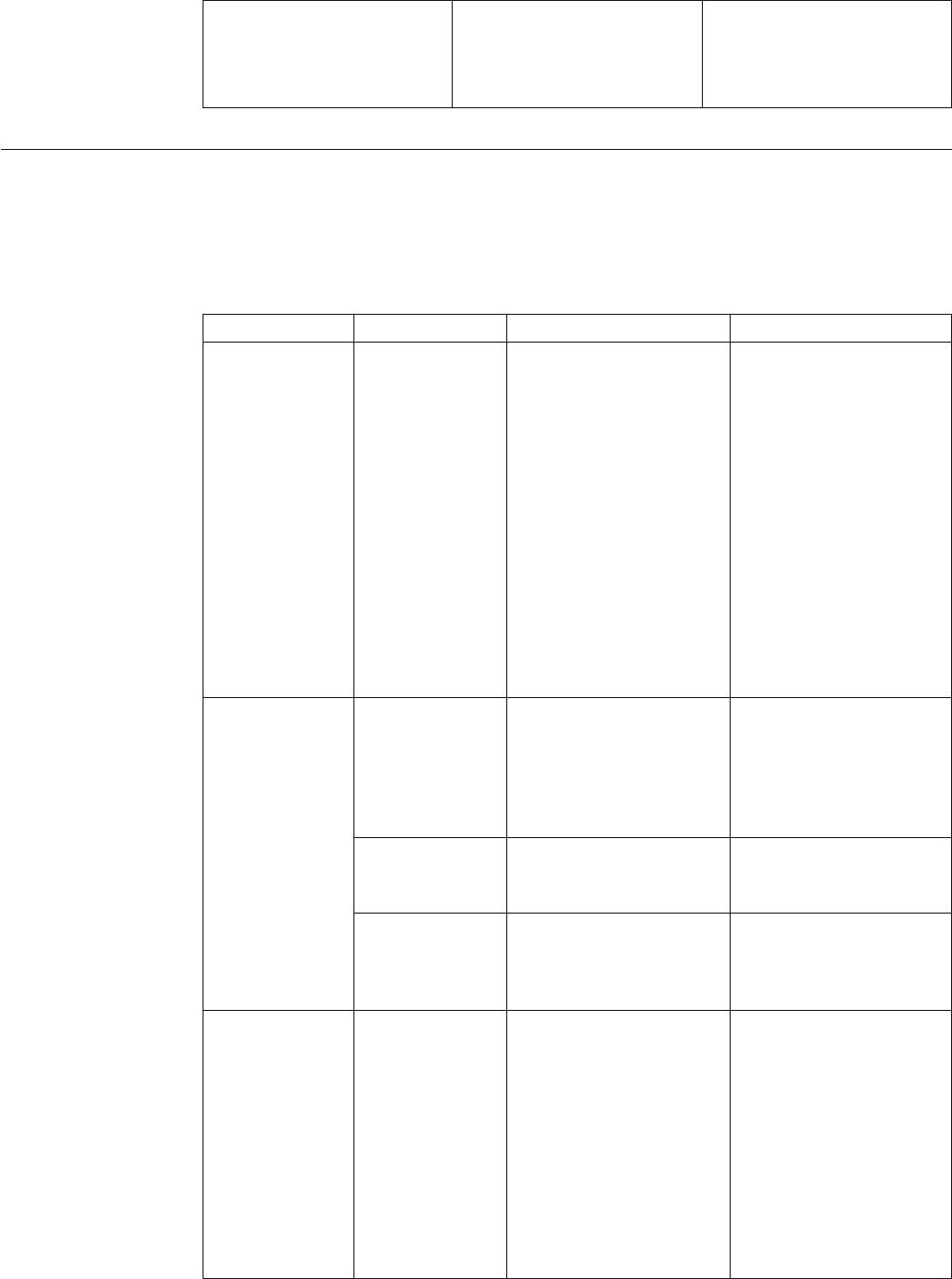
Table 3-1. Monitor specifications for type-model 9417-Axx (continued)
Humidity Operating
Storage
Shipping
10% to 80%
5% to 95%
5% to 95%
Troubleshooting
If you have a problem setting up or using your monitor, you might be able to
solve it yourself. Before calling your dealer or IBM, try the suggested actions that
are appropriate to your problem.
Table 3-2. Troubleshooting
Problem Possible cause Suggested action Reference
The words ″Out
of Range″ are
shown on the
screen, and the
power indicator
is flashing green.
The system is set
to a display
mode which is
not supported by
the monitor.
v If you are replacing an
old monitor, reconnect
it and adjust the
display mode to within
the specified range for
your new monitor.
v If using a Windows
system, restart the
system in safe mode,
then select a supported
display mode for your
computer.
v If these options do not
work, contact the IBM
Support Center.
“Selecting a supported
display mode” on page
2-5
The image
quality is
unnacceptable.
The video signal
cable is not
connected with
the monitor or
system
completely.
Be sure the signal cable is
firmly plugged into the
system and monitor.
“Connecting and turning
on your monitor” on
page 1-3
The color
settings may be
incorrect.
Select another color
setting from the OSD
menu.
“Adjusting your monitor
image” on page 2-3
The automatic
image setup
function was not
performed.
Perform automatic image
setup.
“Adjusting your monitor
image” on page 2-3
The power
indictator is not
lit and there is
no image.
v The monitor’s
power switch
is not
switched on.
v The power
cord is loose
or
disconnected.
v There is no
power at the
outlet.
v Be sure the power cord
is connected properly.
v Be sure the outlet has
power.
v Power on the monitor.
v Try using another
power cord.
v Try using another
electrical outlet.
“Connecting and turning
on your monitor” on
page 1-3
3-2 L171 Flat Panel Monitor User’s Guide
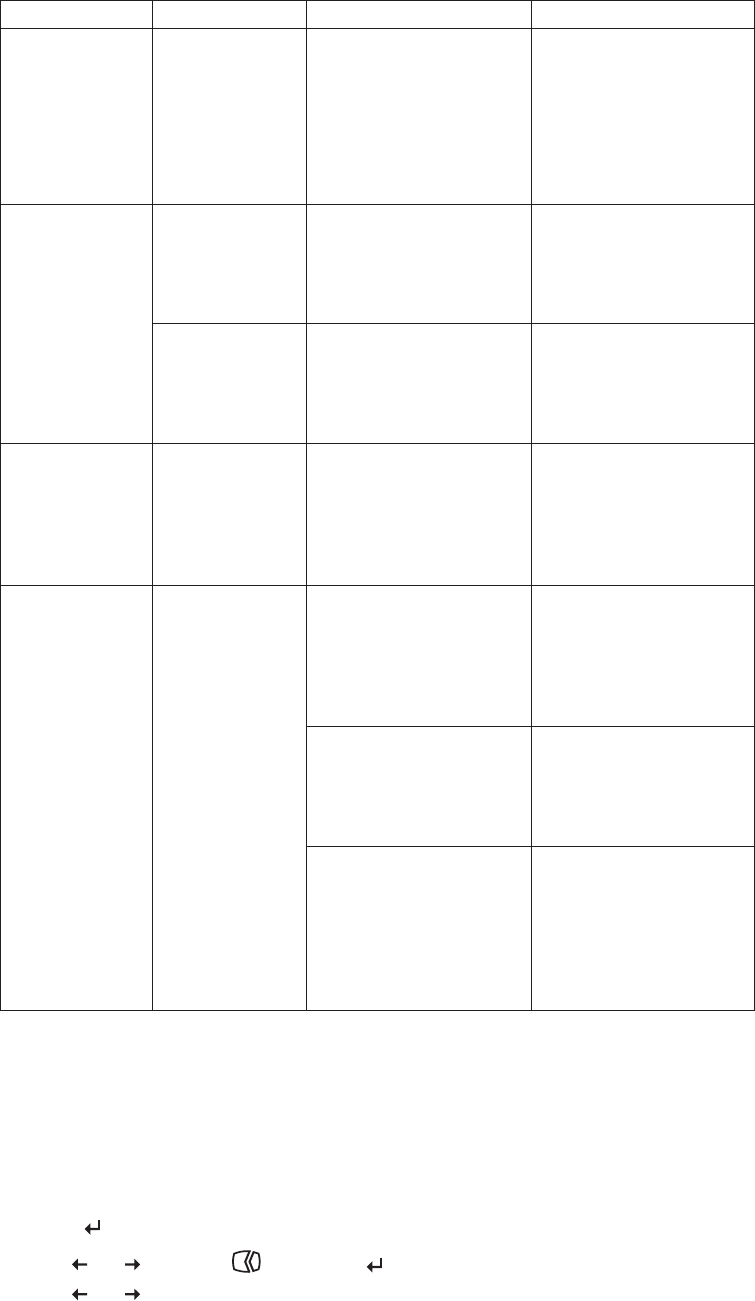
Table 3-2. Troubleshooting (continued)
Problem Possible cause Suggested action Reference
Screen is blank
and power
indicator is
steady amber or
flashing green
The monitor is in
Standby/Suspend
mode
v Press any key on the
keyboard or move the
mouse to restore
operation.
v Check the Power
Options settings on
your computer.
“Understanding power
management” on page
2-6
The power
indicator is
green, but there
is no image.
The video signal
cable is loose or
disconnected
from the system
or monitor.
Be sure the video cable is
connected with the
system properly.
“Connecting and turning
on your monitor” on
page 1-3
The monitor
brightness and
contrast are at
the lowest
setting.
Adjust the brightness and
contrast setting on the
OSD menu.
“Adjusting your monitor
image” on page 2-3
One or more of
the pixels appear
discolored
This is a
characteristic of
the LCD
technology and
is not an LCD
defect.
If there are more than
five pixels missing,
contact the IBM Support
Center.
Appendix A, “Service and
Support,” on page A-1
v Fuzzy lines in
text or a
blurry image.
v Horizontal or
vertical lines
through the
image.
v Image setup
has not been
optimized
v Your system
Display
Properties
setting have
not been
optimized.
Adjust the resolution
settings on your system
to match the native
resolution for this
monitor: 1280 x 1024 at 60
Hz.
“Adjusting your monitor
image” on page 2-3
“Manual image setup”
Perform automatic image
setup. If automatic image
setup does not help,
perform manual image
setup.
“Selecting a supported
display mode” on page
2-5
When working in the
native resolution, you
may find additional
improvements by
adjusting the Dots Per
Inch (DPI) setting on
your system.
See the Advanced section
of your system’s display
properties.
Manual image setup
If automatic image setup does not establish the image that you prefer, perform
manual image setup.
Note: Have your monitor powered on for about 15 minutes, until the monitor
warms up.
1. Press
at the bottom of the monitor to open the OSD menu.
2. Use
or
to select
and press
to access.
3. Use
or
to select Clock and Phase adjustment.
Chapter 3. Reference information 3-3

v Clock (pixel frequency) adjusts the number of pixels scanned by one
horizontal sweep. If the frequency is not correct, the screen shows vertical
stripes and the picture does not have the correct width.
v Phase adjusts the phase of the pixel clock signal. With a wrong phase
adjustment, the picture has horizontal disturbances in light picture.
4. When the image no longer looks distorted, save the Clock and Phase
adjustments.
5. Press
to leave the OSD menu.
Manually installing the monitor driver
Below are steps for manually installing the monitor driver in Microsoft
®
Windows
XP
®
and Microsoft Windows 2000 Professional. Please see the Install Driver section
of the Reference and Driver CD for automatic installation.
Installing the monitor driver in Windows XP
To use the Plug and Play feature in Windows XP, files should be loaded from the
Reference and Driver CD.
Note: This section must be completed before continuing with the Windows XP
automatic image setup.
1. Turn off the computer and all attached devices.
2. Ensure that the monitor is connected correctly.
3. Turn on the monitor and then the system unit. Allow the system to boot into
Windows XP.
4. Open the Display Properties window by clicking Start →Settings →Control
Panel, and then double-clicking the Display icon.
5. Click the Settings tab.
6. Click the Advanced button.
7. Click the Monitor tab.
8. Click the Properties button.
9. Click the Drivers tab.
10. Open the Hardware Update Wizard window by clicking on Update Driver,
and then click Next.
11. Select Install from a list or Specific location(Advanced), and then click Next.
12. Insert the Setup CD into the CD drive, then click the Have Disk button.
13. Click OK.
14. Ensure that the CD drive letter is selected.
15. Choose ThinkVision L171 Monitor and click OK. The files will be copied
from the CD to your hard disk drive.
16. Close all open windows and remove the CD.
17. Restart the system. The system will automatically select the maximum refresh
rate and corresponding Color Matching Profiles.
Note: On LCD monitors, unlike CRTs, a faster refresh rate does not improve
display quality. IBM recommends using either 1280 x 1024 at a refresh rate of 60
Hz, or 640 x 480 at a refresh rate of 60 Hz.
Installing the monitor driver in Windows 2000
To use the Plug and Play feature in Windows 2000, files should be loaded from the
Reference and Driver CD.
3-4 L171 Flat Panel Monitor User’s Guide
Note: This section must be completed before continuing with the Windows 2000
automatic image setup.
1. Turn off the computer and all attached devices.
2. Ensure that the monitor is connected correctly.
3. Turn on the monitor and then the system unit. Allow the system to boot into
Windows 2000.
4. Open the Display Properties window by clicking Start →Settings →Control
Panel, and then double-clicking the Display icon.
5. Click the Settings tab.
6. Click the Advanced button.
7. Click the Monitor tab.
8. Click the Properties button.
9. Click the Drivers tab.
10. Open the Upgrade Device Driver Wizard window by clicking on Update
Driver, and then click Next.
11. Select Display a list of the known drivers for this device so that I can
choose a specific driver, and then click Next.
12. Insert the Setup CD into the CD drive, then click the Have Disk button.
13. Click OK.
14. Ensure that the CD drive letter is selected.
15. Choose ThinkVision L171 Monitor and click OK. The files will be copied
from the CD to your hard disk drive.
16. Close all open windows and remove the CD.
17. Restart the system. The system will automatically select the maximum refresh
rate and corresponding Color Matching Profiles.
Note: On LCD monitors, unlike CRTs, a faster refresh rate does not improve
display quality. IBM recommends using either 1280 x 1024 at a refresh rate of 60
Hz, or 640 x 480 at a refresh rate of 60 Hz.
Getting further help
If you still can’t solve your problem, please contact the IBM Support Center. For
more information on contacting the IBM Support Center, please see Appendix A,
“Service and Support,” on page A-1.
Chapter 3. Reference information 3-5
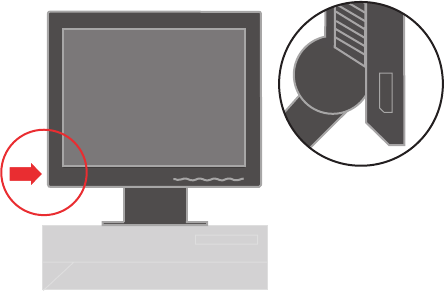
Service information
Product numbers
The product number for your monitor is located on the side of the display bezel as
shown below.
Customer responsibilities
The warranty does not apply to a product which has been damaged due to
accident, misuse, abuse, improper installation, usage not in accordance with
product specifications and instructions, natural or personal disaster, or
unauthorized alterations, repairs or modifications.
The following are examples of misuse or abuse and not covered by warranty:
v Images burned onto the screen of a CRT monitor. Burned image is preventable
by utilizing a moving screen saver or power management.
v Physical damage to covers, bezel, base and cables.
v Scratches or punctures on monitor screens.
3-6 L171 Flat Panel Monitor User’s Guide
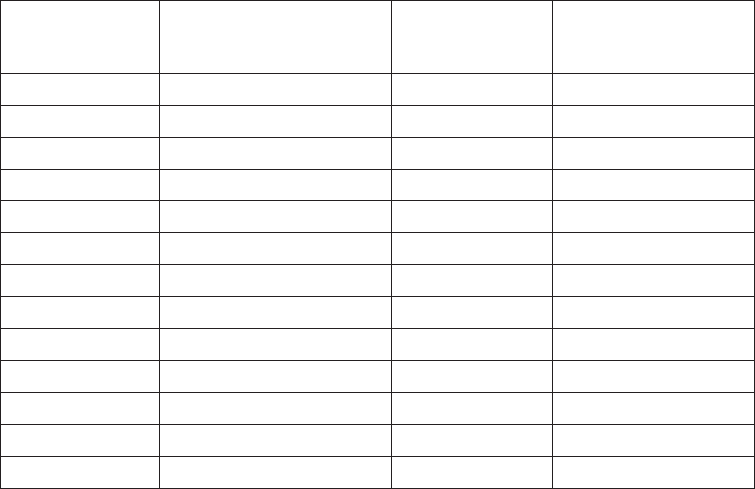
IBM service parts
The following parts are for use by IBM service, or IBM authorized dealers, to
support the customer warranty. Parts are for service use only. The table below
shows information for model 9417-Axx.
Table 3-3. List of IBM service parts
FRU (Field
Replaceable Unit)
Part number Description Color
Machine Type Model
(MTM)
30R5135 Monitor- L171 Black 9417-AB1
30R5136 Monitor- L171 Black 9417-AJ1
30R5139 Video cable 9417-AB1, 9417-AJ1
30R5140 Stand Black 9417-AB1, 9417-AJ1
30R5141 Base Black 9417-AB1, 9417-AJ1
30R5043 Monitor- L171 Black 9417-AB7
30R5047 Video cable 9417-AB7
30R5048 Stand Black 9417-AB7
30R5049 Base Black 9417-AB7
30R5027 Monitor- L171 Black 9417-AB9
30R5030 Video cable 9417-AB9
30R5031 Stand Black 9417-AB9
30R5032 Base Black 9417-AB9
Chapter 3. Reference information 3-7
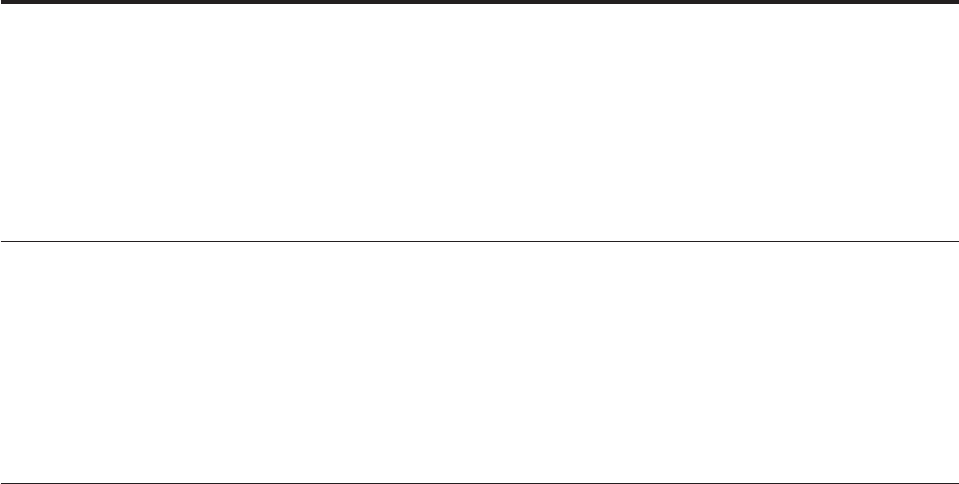
Appendix A. Service and Support
The following information describes the technical support that is available for your
product, during the warranty period or throughout the life of the product. Refer to
your IBM Statement of Limited Warranty for a full explanation of IBM warranty
terms.
Online technical support
Online technical support is available during the life of your product through the
Personal Computing Support Web site at http://www.ibm.com/pc/support.
During the warranty period, assistance for replacement or exchange of defective
components is available. In addition, if your IBM product is installed in an IBM
computer, you might be entitled to service at your location. Your technical support
representative can help you determine the best alternative.
Telephone technical support
Installation and configuration support through the IBM Support Center will be
withdrawn or made available for a fee, at IBM’s discretion, 90 days after the
product has been withdrawn from marketing. Additional support offerings,
including step-by-step installation assistance, are available for a nominal fee.
To assist the technical support representative, have available as much of the
following information as possible:
v Product name
v Product number
v Proof of purchase
v Computer manufacturer, model, serial number (if IBM), and manual
v Exact wording of the error message (if any)
v Description of the problem
v Hardware and software configuration information for your system
If possible, be at your computer. Your technical support representative might want
to walk you through the problem during the call.
For the support telephone number and support hours by country, refer to the
following table. If the number for your country or region is not listed, contact your
IBM reseller or IBM marketing representative. Response time may vary depending
on the number and nature of the calls received.
Phone numbers are subject to change without notice. For the latest phone number
list, go to http://www.ibm.com/pc/support and click Support Phone List.
© Copyright IBM Corp. 2005 A-1
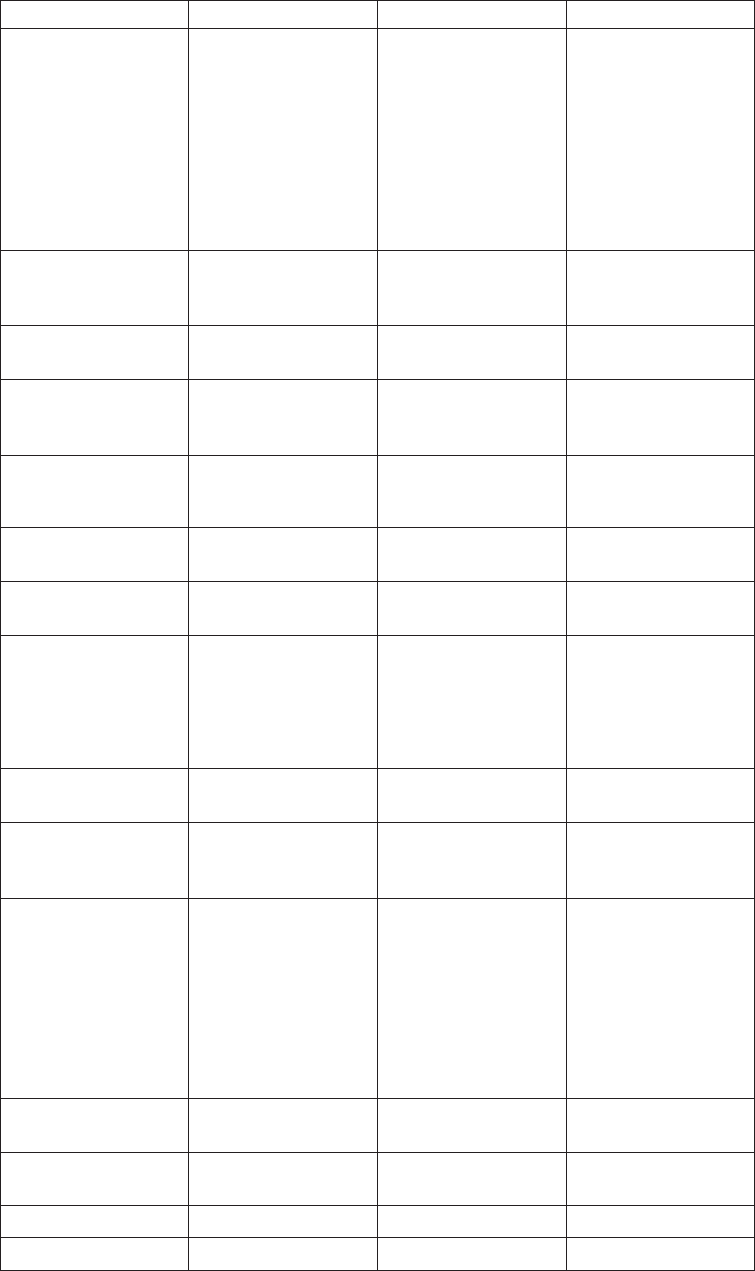
Country or Region Language Telephone Number Hours of operation
Africa -- Africa: +44 (0)1475
555 055
South Africa: +27 11
3028888 and
0800110756
Central Africa:
Contact the nearest
IBM Business Partner
--
Argentina Spanish 0800-666-0011 9AM - 10PM
Monday-Friday
(Local time)
Australia English 131-426 9AM - 9PM AEST 7
days/week
Austria German +43-1-24592-5901 9AM - 5:30PM,
Monday - Friday
(Local time)
Belgium Dutch
French
02-210-9820
02-210-9800
9AM - 5PM Monday
-Friday (Local time)
Bolivia Spanish 0800-0189 8AM - 9PM Monday
-Friday (Local time)
Brazil Portuguese 55-11-3889-8986 8AM - 6PM Monday
-Friday (Local time)
Canada English
French
1-800-565-3344
1-800-565-3344
In Toronto only call:
416-383-3344
24 hours/day, 7
days/week
Chile Spanish 800-224-488 8AM - 9PM Monday
-Friday (Local time)
China Mandarin 800 810 1818 8:30AM - 5PM
Monday -Friday
(Local time)
China (Hong Kong
S.A.R.)
Cantonese, English,
Putonghua
Home PC: 852 2825
7799
Commercial PC: 852
8205 0333
ThinkPad and
WorkPad: 852 2825
6580
9AM - 5PM Monday
-Friday (Local time)
Colombia Spanish 1-800-912-3021 8AM - 9PM EST
Monday -Friday
Costa Rica Spanish 284-3911 8AM - 5PM Monday
-Friday (Local time)
Cyprus -- +357-22-841100 --
Czech Republic -- +420-2-7213-1316 --
A-2 L171 Flat Panel Monitor User’s Guide
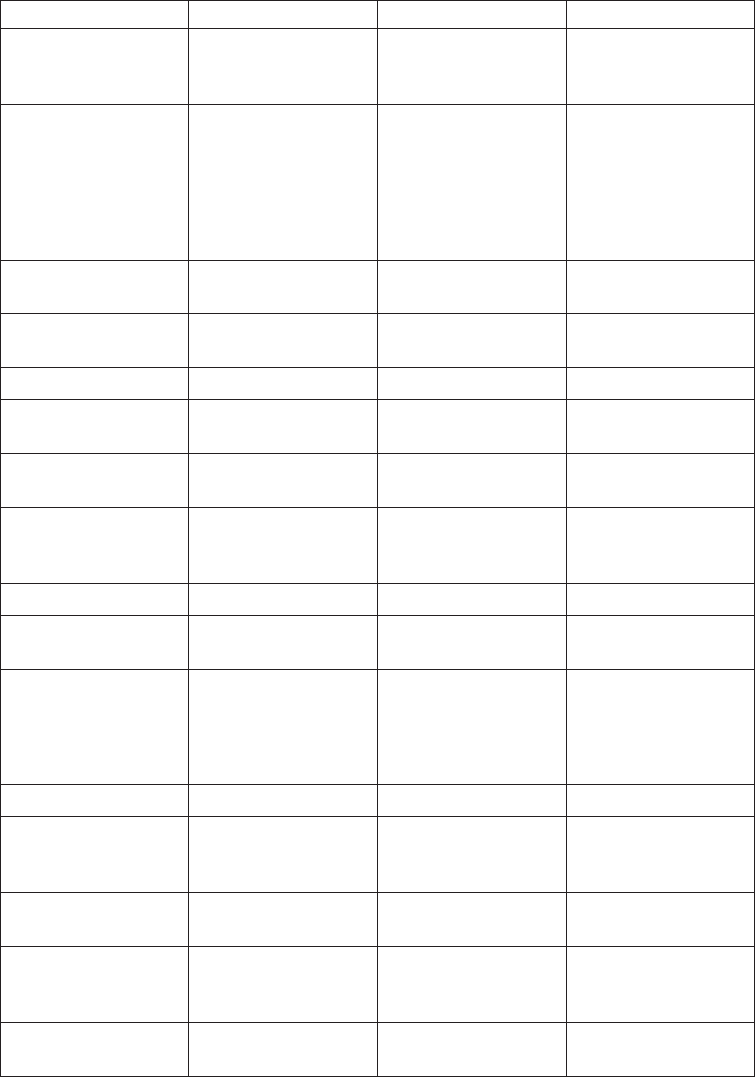
Country or Region Language Telephone Number Hours of operation
Denmark Danish 4520-8200 8:30AM - 4:30PM
Monday -Friday
(Local time)
Dominican Republic Spanish 566-4755
566-5161 ext. 8201
Toll Free within the
Dominican Republic:
1-200-1929
8AM - 5PM Monday
-Friday (Local time)
Ecuador Spanish 1-800-426911 7AM - 8PM Monday
-Friday (Local time)
El Salvador Spanish 250-5696 8AM - 5PM Monday
-Friday (Local time)
Estonia -- +386-61-1796-699 --
Finland Finnish +358-9-459-6960 9AM - 5PM Monday
-Friday (Local time)
France French +33-238-557-450 9AM - 6PM Monday
-Friday (Local time)
Germany German +49-7032-15-49201 9AM - 5:30PM
Monday -Friday
(Local time)
Greece -- +30-210-680-1700 --
Guatemala Spanish 335-8490 8AM - 5PM Monday
-Friday (Local time)
Honduras Spanish Tegucigalpa & San
Pedro Sula: 232-4222
San Pedro Sula:
552-2234
8AM - 5PM Monday
-Friday (Local time)
Hungary -- +36-1-382-5720 --
India English 1600-44-6666 9AM - 6PM Monday
-Friday (Local time)
Except holidays
Indonesia Bahasa, Indonesian,
English
800-140-3555 8AM - 6PM Monday
-Friday (Local time)
Ireland English +353-(0)1-815-9200 9AM - 5:30PM
Monday -Friday
(Local time)
Italy Italian +39-02-7031-6101 9AM - 5PM Monday
-Friday (Local time)
Appendix A. Service and Support A-3
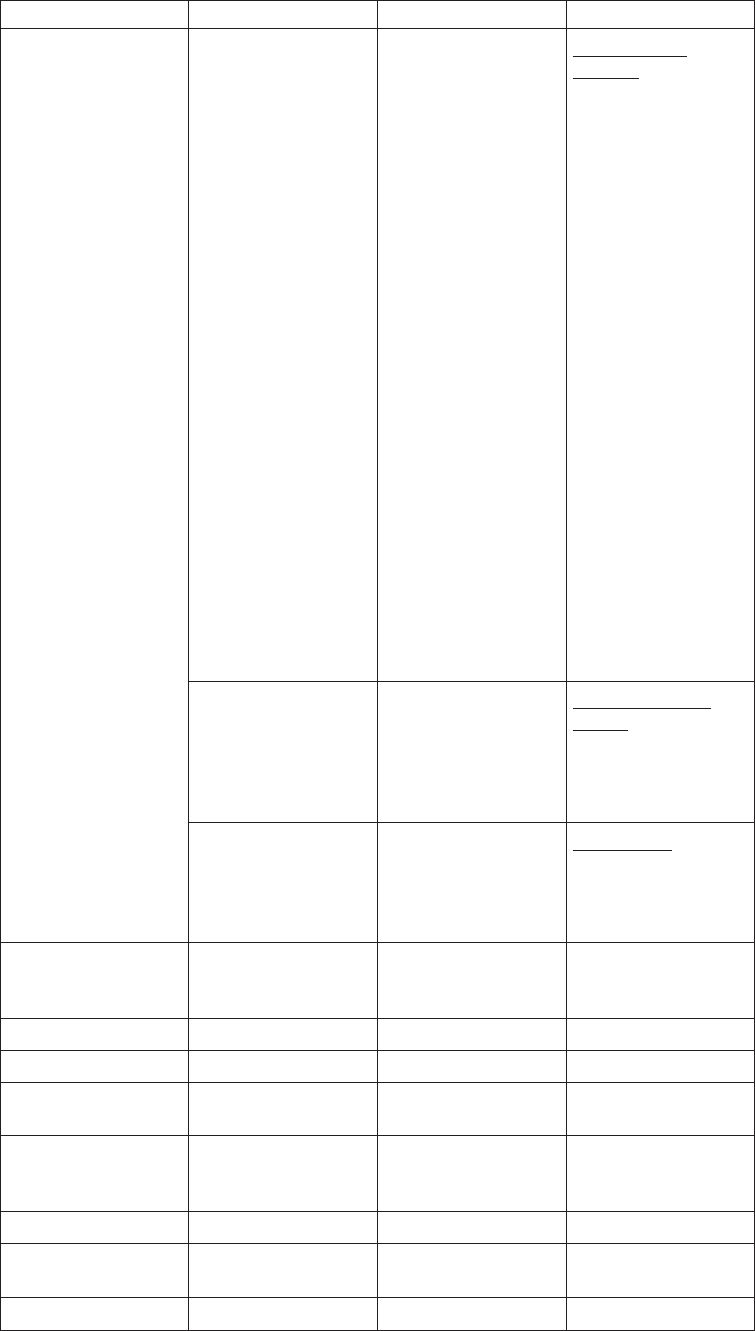
Country or Region Language Telephone Number Hours of operation
Japan Japanese, English Desktop
Toll free:
0120-887-870; For
International:
+81-46-266-4724
ThinkPad
Toll free:
0120-887-874; For
International:
+81-46-266-4724
Both of the above
numbers will be
answered with a
Japanese language
voice prompt. For
telephone support in
English, please wait
for the Japanese
voice prompt to end,
and an operator will
answer. Please ask
for ″English support
please″, and your call
will be transferred to
an English speaking
operator.
ThinkPad and
Desktop 10AM - 6PM
Everyday Except
Second Sunday of the
month, Year end
Japanese IntelliStation and
xSeries Inside Japan
and Overseas calls:
+81-46-266-1358
IntelliStation and
xSeries 9AM - 5PM
Monday - Friday
Except Saturday,
Sunday, Holidays,
Year End
Japanese PC Software
0120-558-695
(Overseas calls:
+81-44-200-8666)
PC Software 10AM -
6PM Monday -
Friday Except
Saturday, Sunday,
Holidays, Year End
Korea Korean 82-2-3284-1500 9AM - 6PM Monday
- Friday 9AM - 1PM
Saturday
Latvia -- +386-61-1796-699 --
Lithuania -- +386-61-1796-699 --
Luxembourg French +352-298-977-5063 9AM - 5PM Monday
- Friday (Local time)
Malaysia English 1800-88-8558 8:30AM - 5PM
Monday - Friday
(Local time)
Malta -- +356-23-4175 --
Mexico Spanish 001-866-434-2080 7AM - 8PM Monday
- Friday (Local time)
Middle East -- +44 (0)1475-555-055 --
A-4 L171 Flat Panel Monitor User’s Guide
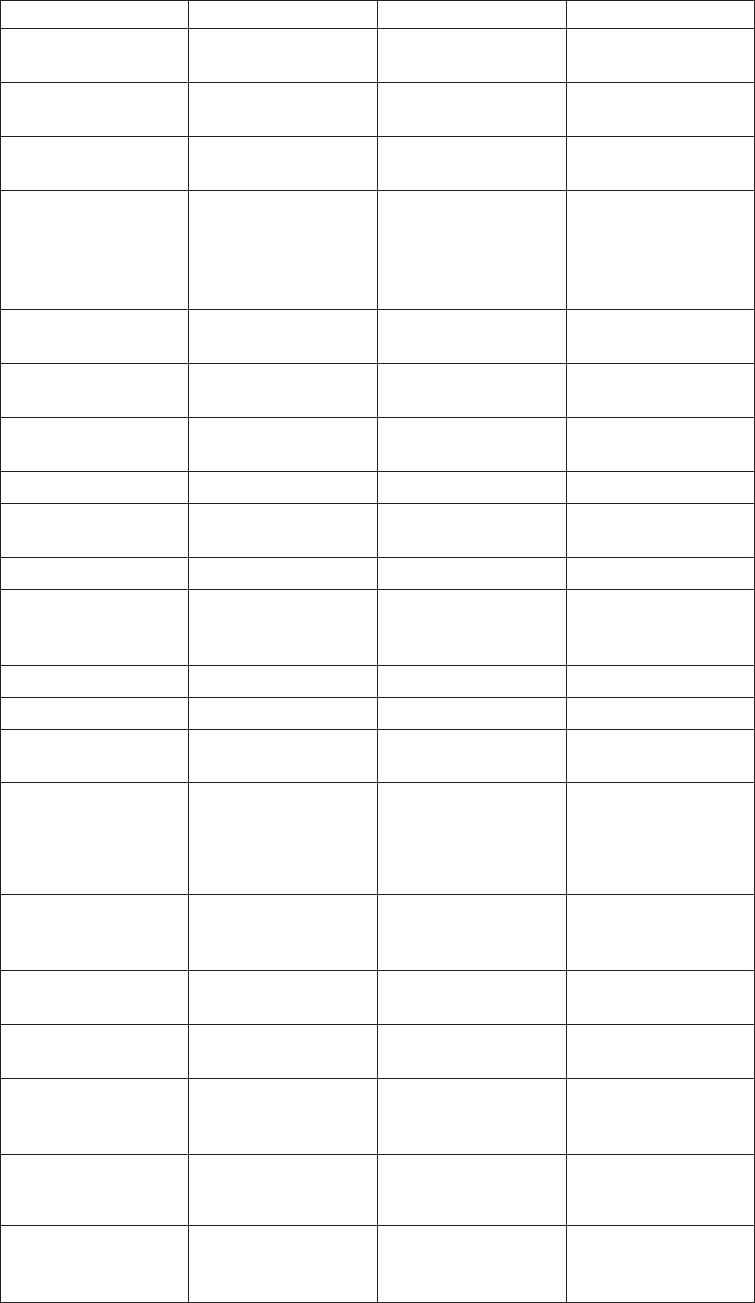
Country or Region Language Telephone Number Hours of operation
Netherlands Dutch +31-20-514-5770 9AM - 5PM Monday
- Friday (Local time)
New Zealand English 0800-446-149 9AM - 9PM 7
days/week
Nicaragua Spanish 255-6658 8AM - 5PM Monday
- Friday (Local time)
Norway Norwegian NetVista,
ThinkCentre, and
ThinkPad: +47 6699
8960 All products:
+47 815 21550
8:30AM - 4:30PM
Monday - Friday
(Local time)
Panama Spanish 206-6047 8AM - 5PM Monday
- Friday (Local time)
Peru Spanish 0-800-50-866 7AM - 8PM Monday
- Friday (Local time)
Philippines English 1800-1888-1426 9AM - 5PM Monday
- Friday (Local time)
Poland -- +48-22-878-6999 --
Portugal Portuguese +351-21-892-7147 9AM - 5PM Monday
- Friday (Local time)
Russian Federation Russian +7-095-940-2000 --
Singapore English 1800-3172-888 8AM - 6:30PM
Monday - Friday
(Local time)
Slovakia -- +421-2-4954-1217 --
Slovenia -- +386-1-5830-050 --
Spain Spanish +34-91-714-7983 9AM - 5PM Monday
- Friday (Local time)
Sri Lanka English +94-11-2448-442
+94-11-2421-066
+94-11-2493-500
8:30AM - 5PM
Monday - Friday
(Local time) Except
Holidays
Sweden Swedish +46-8-477-4420 8:30AM - 4:30PM
Monday - Friday
(Local time)
Switzerland German, French,
Italian
+41-58-333-0971 9AM - 5PM Monday
- Friday (Local time)
Taiwan Mandarin 886-2-8723-9799 24 hours/day, 7
days/week
Thailand Thai 1-800-299-229 8AM - 6PM Monday
- Friday (Local time)
Except Holidays
Turkey Turkish 00800-211-4032
+90-212-317-1760
9AM - 6PM Monday
- Friday (Local time)
United Kingdom English +44-1475-555-055 9AM - 5:30PM
Monday - Friday
(Local time)
Appendix A. Service and Support A-5
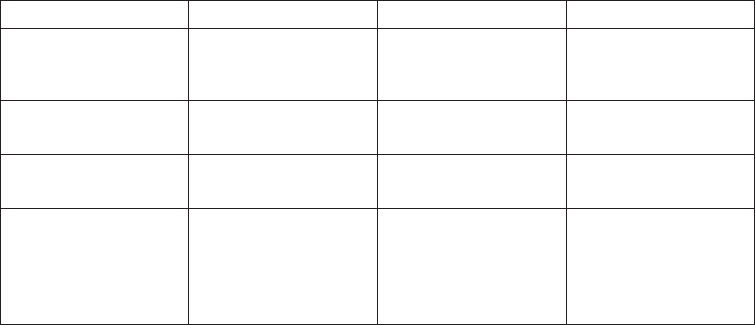
Country or Region Language Telephone Number Hours of operation
United States English 1-800-IBM-SERV
(1-800-426-7378)
24 hours/day, 7
days/week
Uruguay Spanish 000-411-005-6649 9AM - 10PM Monday
- Friday (Local time)
Venezuela Spanish 0-800-100-2011 8AM - 9PM Monday
- Friday (Local time)
Vietnam English/Vietnamese Ho Chi Minh = (848)
824-1474
Hanoi = (844)
842-6316
9AM - 5PM Monday
- Friday (Local time)
A-6 L171 Flat Panel Monitor User’s Guide

Appendix B. Notices
IBM may not offer the products, services, or features discussed in this document in
all countries. Consult your local IBM representative for information on the
products and services currently available in your area. Any reference to an IBM
product, program, or service is not intended to state or imply that only that IBM
product, program, or service may be used. Any functionally equivalent product,
program, or service that does not infringe any IBM intellectual property right may
be used instead. However, it is the user’s responsibility to evaluate and verify the
operation of any non-IBM product, program, or service.
IBM may have patents or pending patent applications covering subject matter
described in this document. The furnishing of this document does not give you
any license to these patents. You can send license inquiries, in writing, to:
IBM Director of Licensing
IBM Corporation
North Castle Drive
Armonk, NY 10504-1785
U.S.A.
INTERNATIONAL BUSINESS MACHINES CORPORATION PROVIDES THIS
PUBLICATION “AS IS” WITHOUT WARRANTY OF ANY KIND, EITHER
EXPRESS OR IMPLIED, INCLUDING, BUT NOT LIMITED TO, THE IMPLIED
WARRANTIES OF NON-INFRINGEMENT, MERCHANTABILITY OR FITNESS
FOR A PARTICULAR PURPOSE. Some jurisdictions do not allow disclaimer of
express or implied warranties in certain transactions, therefore, this statement may
not apply to you.
This information could include technical inaccuracies or typographical errors.
Changes are periodically made to the information herein; these changes will be
incorporated in new editions of the publication. IBM may make improvements
and/or changes in the product(s) and/or the program(s) described in this
publication at any time without notice.
The products described in this document are not intended for use in implantation
or other life support applications where malfunction may result in injury or death
to persons. The information contained in this document does not affect or change
IBM product specifications or warranties. Nothing in this document shall operate
as an express or implied license or indemnity under the intellectual property rights
of IBM or third parties. All information contained in this document was obtained
in specific environments and is presented as an illustration. The result obtained in
other operating environments may vary.
IBM may use or distribute any of the information you supply in any way it
believes appropriate without incurring any obligation to you.
Any references in this publication to non-IBM Web sites are provided for
convenience only and do not in any manner serve as an endorsement of those Web
sites. The materials at those Web sites are not part of the materials for this IBM
product, and use of those Web sites is at your own risk.
Any performance data contained herein was determined in a controlled
environment. Therefore, the result obtained in other operating environments may
© Copyright IBM Corp. 2005 B-1

vary significantly. Some measurements may have been made on development-level
systems and there is no guarantee that these measurements will be the same on
generally available systems. Furthermore, some measurements may have been
estimated through extrapolation. Actual results may vary. Users of this document
should verify the applicable data for their specific environment.
Note: As an ENERGY STAR Partner, IBM has determined that this product meets
the guidelines for energy efficiency.
Trademarks
The following terms are trademarks of International Business Machines
Corporation in the United States, other countries, or both:
IBM
ThinkVision
Microsoft and Windows are trademarks of Microsoft Corporation in the United
States, other countries, or both.
ENERGY STAR and the ENERGY Star logo are registered US trademarks.
Other company, product, or service names may be trademarks or service marks of
others.
B-2 L171 Flat Panel Monitor User’s Guide
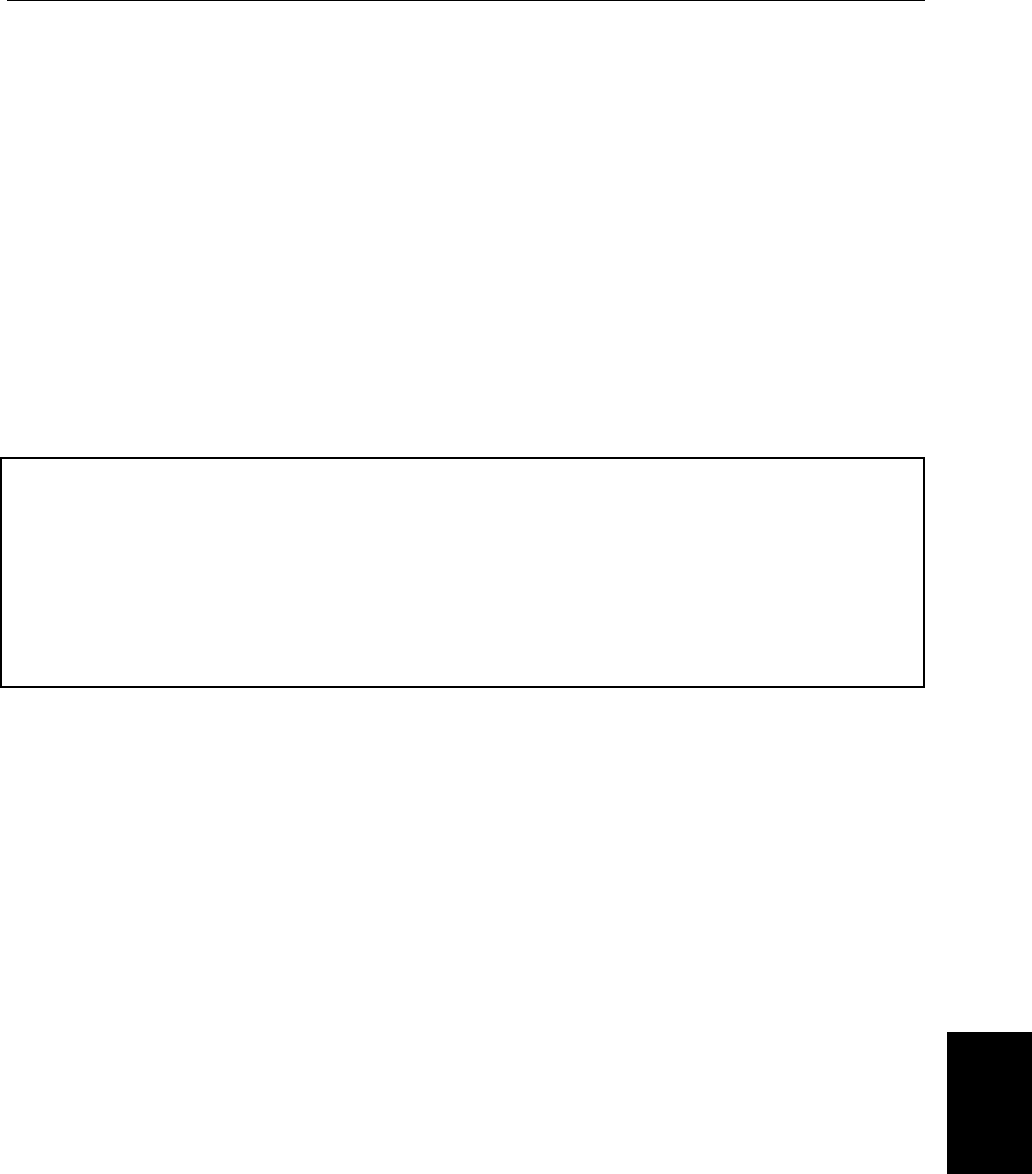
1
APPENDIX
Compliances
This equipment has been tested and found to comply with the limits for a Class B digital device, pursuant to
Part 15 of the FCC Rules. These limits are designed to provide reasonable protection against harmful
interference in a residential installation. This equipment generates, uses, and can radiate radio frequency
energy and, if not installed and used in accordance with the instructions, may cause harmful interference to
radio communications. However, there is no guarantee that interference will not occur in a particular
installation. If this equipment does cause harmful interference to radio or television reception, which can be
determined by turning the equipment off and on, the user is encouraged to try to correct the interference by
one or more of the following measures:
•Reorient or relocate the receiving antenna.
•Increase the separation between the equipment and receiver.
•Connect the equipment into an outlet on a circuit different from that to which the receiver is connected.
•Consult an IBM authorized dealer or service representative for help.
Properly shielded and grounded cables and connectors must be used in order to meet FCC emission limits.
Proper cables and connectors are available from IBM authorized dealers. IBM is not responsible for any radio
or television interference caused by using other than recommended cables and connectors or by
unauthorized changes or modifications to this equipment. Unauthorized changes or modifications could void
the user’s authority to operate the equipment.
Declaration of Conformity Trade name
Trade name: IBM Corporation
Model Nos.: 9329-xx9
Responsible Party: LG Electronics USA Inc.
Address: 6133 North River Road Suite 1100 (Riverview Plaza) Rosemont, Illinois, 60018
Telephone No.: 847-692-4630 ext 329
This Device complies with Part 15 of the FCC Rules. Operation is subject to the following two conditions:
(1) This device may not cause harmful interference, and (2) this device must accept any interference received,
including interference that may cause undesired operation.
Power Cords
For your safety, IBM provides a power cord with a grounded attachment plug to use with this IBM product. To
avoid electrical shock, always use the power cord and plug with a properly grounded power outlet.
IBM power cords used in the United States and Canada are listed by the Underwriter’s Laboratories (UL) and
certified by the Canadian Standards Association (CSA).
For units intended to be operated at 115 volts: Use a UL-listed and CSA-certified cord set consisting of a
minimum 18 AWG, Type SVT or SJT, three-conductor cord, a maximum of 15 feet in length and a parallel
blade, grounding-type attachment plug rated 15 amperes, 125 volts.
For units intended to be operated at 230 volts (U.S. use): Use a UL-listed and CSA-certified cord set
consisting of a minimum 18 AWG, type SVT or SJT, three-conductor cord, a maximum of 15 feet in length
and a tandem blade, grounding-type attachment plug rated 15 amperes, 250 volts.
For units intended to be operated at 230 volts (outside the U.S.): Use a cord set with a grounding-type
attachment plug. The cord set should have the appropriate safety approvals for the country in which the
equipment will be installed.
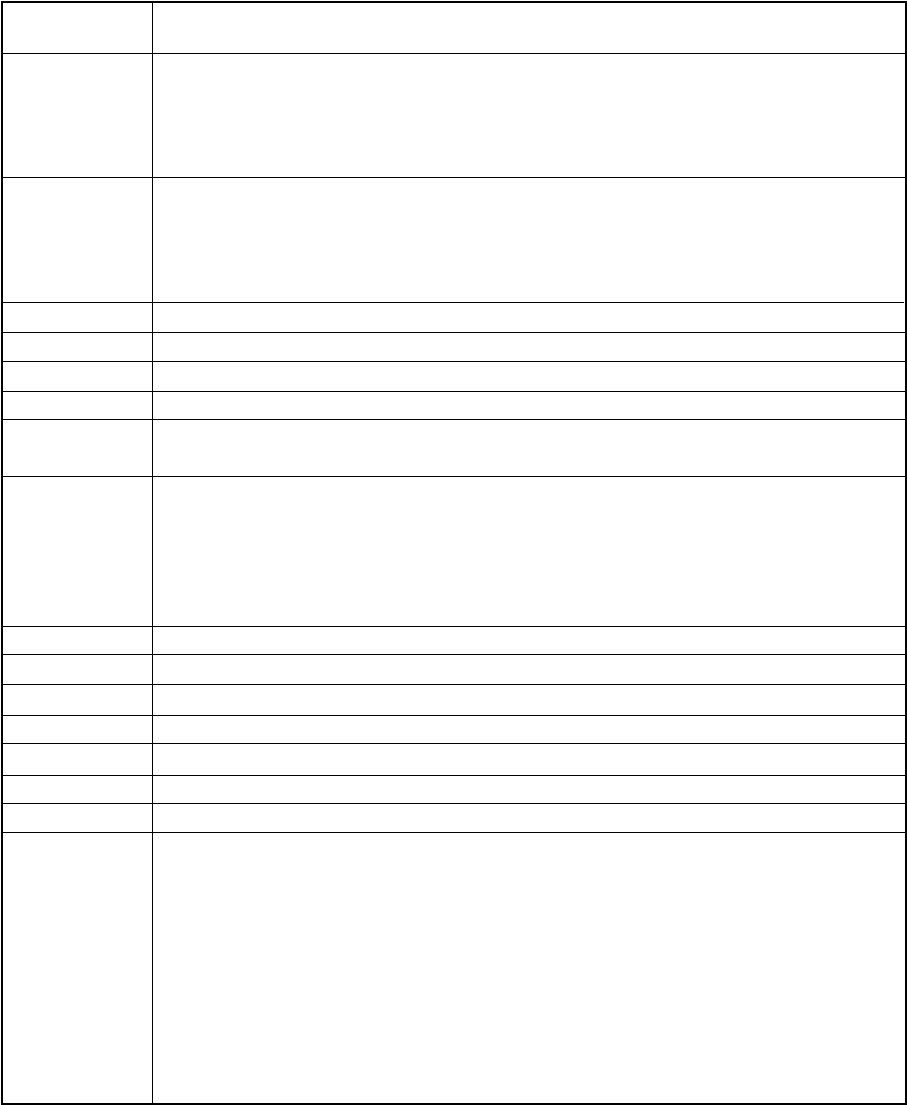
2
IBM power cords for a specific country or region are usually available only in that country or region.
Used in these countries or regions
IBM power cord
part number
74P4360
74P4362
74P4366
74P4368
74P4370
74P4372
74P4374
74P4376
74P4378
74P4380
74P4382
74P4384
74P4386
74P4388
74P4390
74P4364
Antigua and Barbuda, Aruba, Bahamas, Barbados, Belize, Bermuda, Bolivia, Calicos Island,
Canada, Cayman Islands, Costa Rica, Columbia, Cuba, Dominican Republic, Ecuador, El
Salvador, Guam, Guatemala, Haiti, Honduras, Jamaica, Mexico, Micronesia (Federal States of),
Netherlands Antilles, Nicaragua, Panama, Peru, Philippines, Saudi Arabia, Thailand, Taiwan,
United States, Venezuela
Antigua and Barbuda, Aruba, Bahamas, Barbados, Belize, Bermuda, Bolivia, Brazil, Caicos
Islands, Canada, Cayman Islands, Costa Rica, Columbia, Cuba, Dominican Republic, Ecuador,
El Salvador, Guam, Guatemala, Haiti, Honduras, Jamaica, Japan, Mexico, Micronesia (Federal
States of), Netherlands Antilles, Nicaragua, Panama, Peru, Philippines, Taiwan, United States,
Venezuela
Denmark
Liechtenstein, Switzerland
Israel
Chile, Italy, Libyan Arab Jamahiriya
Bangladesh, Lesotho, Maceo, Maldives, Namibia, Nepal, Pakistan, Samoa, South Africa, Sri
Lanka, Swaziland, Uganda
Abu Dhabi, Bahrain, Botswana, Brunei Darussalam, Channel Islands, Cyprus, Dominica,
Gambia, Ghana, Grenada, Guyana, China (Hong Kong S.A.R), Iraq, Ireland, Jordan, Kenya,
Kuwait, Liberia, Malawi, Malaysia, Malta, Myanmar (Burma), Nigeria, Oman, Qatar, Saint Kitts &
Nevis, Saint Lucia, Saint Vincent and the Grenadines, Seychelles, Sierra Leone, Singapore,
Sudan, Tanzania (United Republic of), Trinidad & Tobago, United Arab Emirates (Dubai), United
Kingdom, Yemen, Zambia, Zimbabwe
Australia, Fiji, Kiribati, Nauru, New Zealand, Papua New Guinea
Korea (Democratic Peoples Republic of), Korea (Republic of)
Japan
India
China (PRC)
Brazil
Argentina, Paraguay, Uruguay
Afghanistan, Albania, Algeria, Andorra, Angola, Armenia, Austria, Azerbaijan, Belarus, Belgium,
Benin, Bosnia and Herzegovina, Bulgaria, Burkina Faso, Burundi, Cambodia, Cameroon, Cape
Verde, Central African Republic, Chad, Comoros, Congo (Democratic Republic of), Congo
(Republic of), Cote D'lvoire (Ivory Coast), Croatia (Republic of), Czech Rep, Dahomey, Djibouti,
Egypt, Equatorial Guinea, Eritrea, Estonia, Ethiopia, Finland, France, French Guyana, French
Polynesia, Gabon, Georgia, Germany, Greece, Guadeloupe, Guinea, Guinea Bissau, Hungary,
Iceland, Indonesia, Iran, Kazakhstan, Kyrgyzstan, Laos (Peoples Democratic Republic of),
Latvia, Lebanon, Lithuania, Luxembourg, Macedonia (former Yugoslav Republic of),
Madagascar, Mali, Martinique, Mauritania, Mauritius, Mayotte, Moldova (Republic of), Monaco,
Mongolia, Morocco, Mozambique, Netherlands, New Caledonia, Niger, Norway, Poland,
Portugal, Reunion, Romania, Russian Federation Rwanda, Sao Tome and Principe,
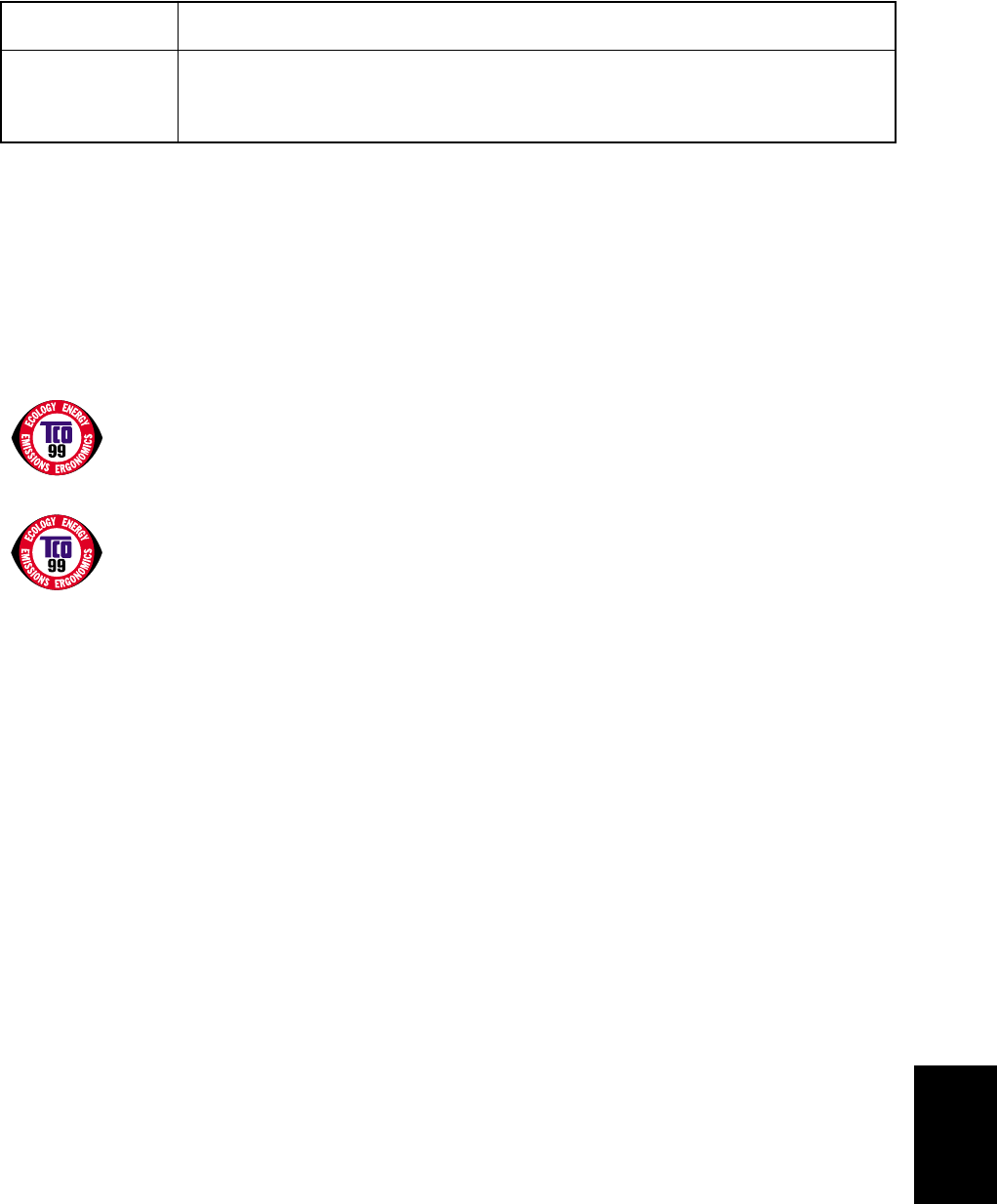
3
APPENDIXAPPENDIX
Industry Canada Class B emission compliance statement
This Class B digital apparatus complies with Canadian ICES-003.
Cet appareil numérique de la classe B respecte toutes les exigences du Réglement sur le matériel
brouilleur du Canada.
Avis de conformité à la réglementation d'Industrie Canada
Cet appareil numérique de classe B est conforme à la norme NMB-003 du Canada.
Used in these countries or regions
IBM power cord
part number
74P4364 Saudi Arabia, Senegal, Serbia, Slovakia, Slovenia (Republic of), Somalia, Spai, Syrian Arab
Republic, Tajikistan, Tahiti, Togo, Tunisia, Turkey, Turkmenistan, Ukraine, Upper Volta,
Uzbekistan, Vanuatu, Vietnam, Wallis and Futuna, Yugoslavia (Federal Republic of), Zaire
Models 9329-xx9 comply with TCO ’99 guidelines.
TCO Compliances Section
Why do we have environmentally labeled computers?
In many countries, environmental labeling has become an established method for encouraging the
adaptation of goods and services to the environment. With the growing manufacture and usage of
electronic equipment throughout the world, there is a recognized concern for the materials and
substances used by electronic products with regards to their eventual recycling and disposal. By proper
selection of these materials and substances, the impact on the environment can be minimized.
There are also other characteristics of a computer, such as energy consumption levels, that are
important from the viewpoints of both the work (internal) and natural (external) environments. Electronic
equipment in offices is often left running continuously, resulting in unnecessary consumption of large
amounts of energy and additional power generation. From the standpoint of carbon emissions alone,
it is vital to save energy.
What does labeling involve?
This product meets the requirements for the TCO’99 scheme which provides for international and
environmental labeling of personal computers. The labeling scheme was developed as a joint effort by
the TCO (The Swedish Confederation of Professional Employees), Svenska Naturskyddsforeningen
(The Swedish Society for Nature Conservation) and Statens Energimyndighet (The Swedish National
Energy Administration)Approval requirements cover a wide range of issues: environment, ergonomics,
emission of electric and magnetic fields, energy consumption and electrical safety
Congratulations!
You have just purchased a TCO’99 approved and labeled product! Your choice has
provided you with a product developed for professional use. Your purchase has also
contributed to reducing the burden on the environment and also to the further
development of environmentally adapted electronics products.
4
Environmental criteria impose restrictions on the presence and use of heavy metals, brominated and
chlorinated flame retardants, CFCs (freons) and chlorinated solvents, and other materials. The
product must be prepared for recycling and the manufacturer is obliged to have an environmental
policy which must be adhered to in each country where the company implements its operational
policy.
Energy requirements include a demand that the computer and/or display, after a certain period of
inactivity, shall reduce its power consumption to a lower level in one or more stages. The length of
time to reactivate the computer shall be reasonable for the user.
Labeled products must meet strict environmental demands, for example, in respect of the reduction
of electric and magnetic fields as well as physical and visual ergonomics.
Below you will find a brief summary of the environmental requirements met by this product.
The complete environmental criteria document may be ordered from:
TCO Development
SE-114 94 STOCKHOLM, Sweden
Fax: +46 8 782 92 07
E-mail (Internet): development@tco.se
Current information regarding TCO’99 approved and labeled products may also be obtained via the
Internet, using the address: http://www.tcodevelopment.com/
Environmental requirements
Flame retardants
Flame retardants are present in printed circuit boards, cables, wires, casings and housings. Their
purpose is to prevent, or at least to delay the spread of fire. Up to 30% of the plastic in a computer
casing can consist of flame retardant substances. Most flame retardants contain bromine or chlorine,
and those flame retardants are chemically related to PCBs. Both the flame retardants containing
bromine or chlorine and the PCBs are suspected of giving rise to health effects, including
reproductive damage in fish-eating birds and mammals, due to the bio-accumulative* processes
when not disposed of in accordance with strict standards for disposal.
The relevant TCO’99 demand requires that plastic components weighing more than 25 grams must
not contain flame retardants with organically bound bromine or chlorine. Flame retardants are
allowed in the printed circuit boards since no substitutes are available.
Cadmium**
Cadmium is present in rechargeable batteries and in the colour-generating layers of certain computer
displays.
The relevant TCO’99 requirement states that batteries, the colour-generating layers of display
screens and the electrical or electronics components must not contain any cadmium.
_______________________________________________________________________________
*Bio-accumulative is defined as substances which accumulate within living organisms.
**Lead, Cadmium and Mercury are heavy metals which are bio-accumulative.
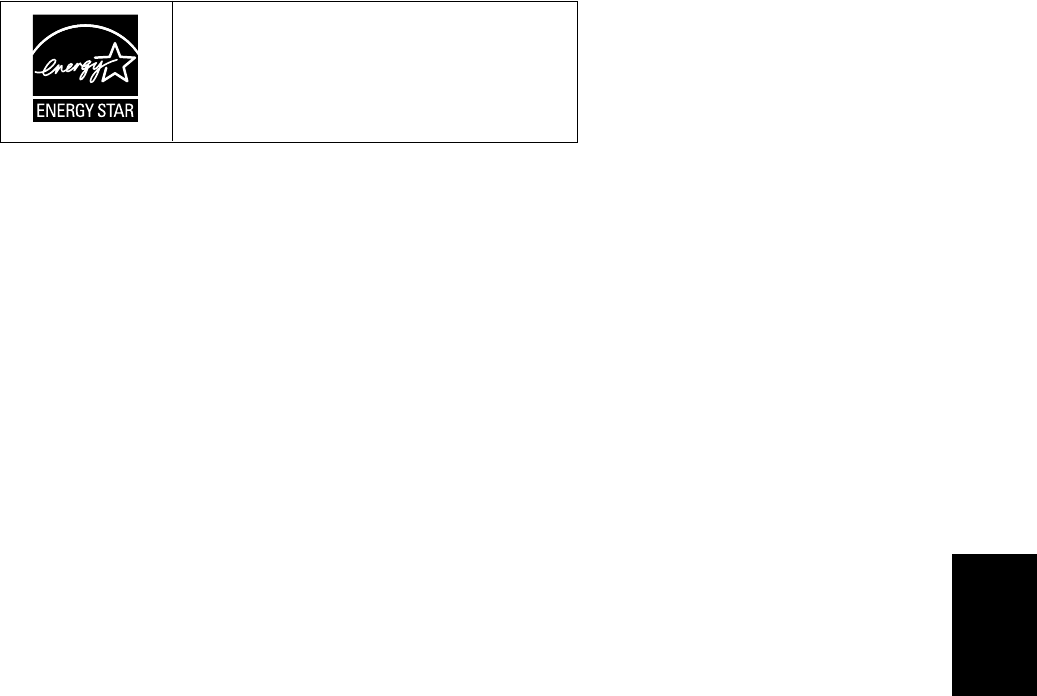
5
APPENDIX
Mercury**
Mercury is sometimes found in batteries, relays and switches. The relevant TCO’99 requirement states
that batteries may not contain any mercury. It also demands that mercury is not present in any of the
electrical or electronics components associated with the labeled unit. There is however one exception.
Mercury is, for the time being, permitted in the back light system of flat panel monitors as there today is
no commercially available alternative. TCO aims on removing this exception when a mercury free
alternative is available.
CFCs (freons)
The relevant TCO’99 requirement states that neither CFCs nor HCFCs may be used during the
manufacture and assembly of the product or in its packaging. CFCs (freons) are sometimes used for
washing printed circuit boards. CFCs break down ozone and thereby damage the ozone layer in the
stratosphere, causing increased reception on earth of ultraviolet light. This restriction assures that
further damage to the ozone layer form this type of equipment will be eliminated.
Lead**
Lead can be found in picture tubes, display screens, solders and capacitors. The relevant TCO’99
requirement permits the inclusion of lead since no replacement has yet been developed.
_______________________________________________________________________________
**Lead, Cadmium and Mercury are heavy metals which are bio-accumulative.
ENERGY STAR®Compliances Section
Congratulations!
You have just purchased an ENERGY STAR®qualified product.
What is an ENERGY STAR®qualified product?
The ENERGY STAR®program is a voluntary partnership between the U.S. Environmental Protection
Agency / Dept. of Energy and Partners to reduce pollution and save energy. An ENERGY STAR®qualified
product meets or exceeds the energy criteria defined in an MOU (Memorandum of Understanding) for
that product category. As an ENERGY STAR®Partner, IBM offers ENERGY STAR®qualified computers,
monitors and printers that meet the growing performance and networking needs of customers while
reducing energy use, saving you money and improving the environment.
IBM is a recognized leader in providing energy efficient office products. In 1998 and 1999, IBM
received the ENERGY STAR®Computer Partner of the Year award in the office equipment category and
in 2001, IBM received the first ENERGY STAR®Excellence in Corporate Commitment award. ENERGY
STAR®products save you more -- look for the ENERGY STAR®label and program information on IBM
products, product literature, Web sites, packaging and promotional material.
As an ENERGY STAR®Partner, IBM Corporation
has determined that this product meets the
ENERGY STAR®guidelines for energy efficiency
6
ENERGY STAR®
Current criteria and information regarding the ENERGY STAR®program can be found at
http://www.energystar.gov
ENERGY STAR®and the ENERGY STAR®logo are registered US marks.
MPRII
This product complies with Swedish National Council for Metrology (MPR) standards issued in
December 1999 (MPRII) for very low frequency (VLF) and Extremely low frequency (ELF) emissions.
Electronic emission notices
Hinweise
Gemäß der Amtsblätter des BMPT Nm. 61Ú1991 und 6Ú1992 wird der Betreiber darauf aufmerksam
gemächt, daß die von ihm mit diesem Gerät zusammengestellte Anlage auch den technischen
Bestimmungen dieser Amtsblätter genügen muß.
Aus ergonomischen Gründen wird empfohlen, die Grundfarbe Blau nicht auf dunklem Untergrund zu
verwenden (schlechte Erkennbarkeit, Augenbelastung bei zu geringem Zeichenkontrast).
Aus ergonomischen Gründen sollten nur Darstellungen auf dunklem Hintergrund bei
Vertikalfrequenzen ab 60 Hz (ohne Zeilensprung) benutzt werden.
Die Konvergenz des Bildes kann sich auf Grund des Magnetfeldes am Ort der Aufstellung aus der
Korrekten Grundeinstellung verändern. Zur Korrektur empfiehlt es sich deshalb, die Regler an der
Frontseite für H STAT und V STAT so einzustellen, daß die getrennt sichtbaren Farblinien für Rot.
Grün und Blau bei z.B. der Darstellung eines Buchstabens zur Deckung (Konvergenz) gelangen. Siehe
hierzu auch die Erklärungen zu H STAT und V STAT.
European Union (EU) Statement
This product is in conformity with the protection requirements of the EU Council Directive 89/366/ECC
on the approximation of the laws of the Member States relating to electromagnetic compatibility
IBM can not accept responsibility for any failure to satisfy the protection requirements resulting from a
non-recommended modification of the product, including the fitting of non-IBM option cards.
This product has been tested and found to comply with the limits for Class B Information Technology
Equipment according to CISPR 22 Ú European Standard EN55024:1998. The limits for Class B
equipment were derived for typical residential environments to provide reasonable protection against
interference with licensed communication devices.
Properly shielded and grounded cables and connectors must be used in order to reduce the potential
for causing interference to radio and TV communications and to other electrical or electronic
equipment. Such cables and connectors are available from IBM authorised dealers.
In accordance with EN 55024:1998 1992, Performance Criterion A:, it should be noted that in the
presence of certain electromagnetic fields, some screen jitter may be observed.
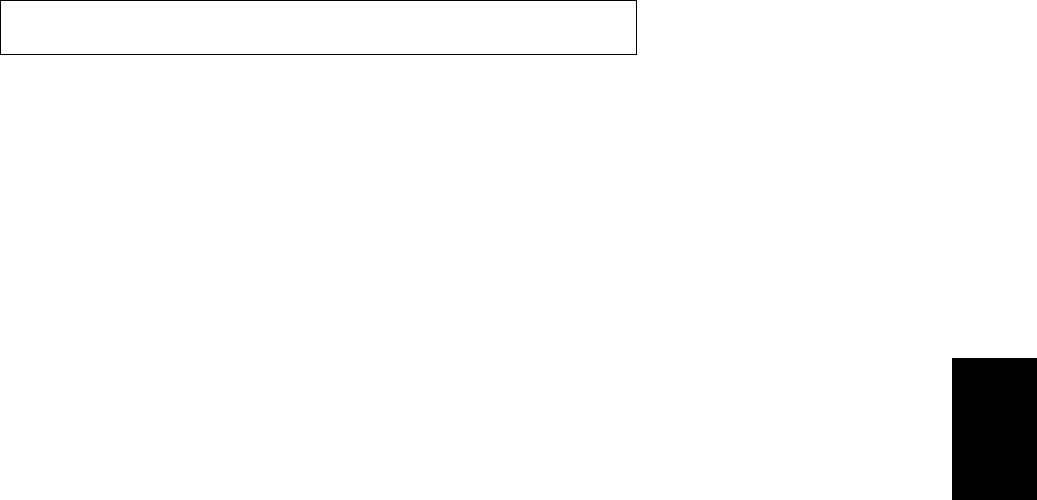
7
APPENDIX
Spécifications de la CEE
Ce produit est conforme aux exigences de protection de la directive 89/ 336/ EEC du Conseil de l’UE
sur le rapprochement des lois des États membres en matière de compatibilité électromagnétique.
IBM ne peut accepter aucune responsabilité pour le manquement aux exigences de protection
résultant d’une modification non recommandée du produit, y compris l’installation de cartes autres que
les cartes IBM.
Ce produit a été testé et il satisfait les conditions de l’équipement informatique de Classe B en vertu de
CISPR22 / Standard européen EN55024:1998. Les conditions pour l’équipement de Classe B ont été
définies en fonction d’un contexte résidentiel ordinaire afin de fournir une protection raisonnable contre
l’interférence d’appareils de communication autorisés.
Des câbles blindés et correctment reliés à la terre doivent être utilisés pour réduire les risques
d’interférence avec des communications radio et télévisées, ainsi qu’avec des équipements électriques
ou électroniques. Ces câbles et connecteurs sont disponibles auprés de vos revendeurs IBM agréés.
Conformément à la norme EN 55024:1998 (Critére de Performance A), l’utilisateur doit être conscient
du fait qu’en présence de certains champs électromagnétiques, l’image peut être instable.
Erklärung für die Europäische Union (EU)
Zulassungbescheinigunglaut dem Deutschen Gesetz über die elektromagnetische Verträglichkeit von
Geräten (EMVG) vom 30. August 1995 (bzw. der EMC EG Richtlinie 89/336):
Dieses Gerät ist berechtigt in Übereinstimmungmit dem Deutschen EMVG das EG-
Konformitätszeichen - CE - zu führen.
Verantwortlich für die Konformitätserklärung nach Paragraph 5 des EMVG ist die:
IBM Deutschland Informationssysteme GmbH, 70548 Stuttgart.
Informationen in Hinsicht EMVG Paragraph 3 Abs. (2) 2:
EN 55022 Hinweis:
“Wird dieses Gerät in einer industriellen Umgebung betrieben (wie in EN 55022:B festgetlegt), dann
kann es dabei eventuell gestört werden. In solch einem FAll ist der Abstand bzw. die Abschirmungzu
der industriellen Störquelle zu vergrößern.”
Anmerkung:
Um die Einhaltung des EMVG sicherzustellen sind die Geräte, wie in den IBM Handbüchern
angegeben, zu installieren und zu betreiben.
Das Gerät erfüllt die Schutzanforderungen nach EN 55024:1998 und
EN55024:1998 Klasse B.
8
Declaración de la Unión Europea (UE)
Este producto satisface los requisitos de protección del Consejo de la UE, Directiva 89/ 336/ CEE en lo
que a la le gislatura de los Estados Miembros sobre compatibilidad electroma gnética se refiere.
IBM no puede aceptar responsabilidad al guna si este producto deja de satisfacer dichos requisitos de
protección como resultado de una modificación no recomendada del producto, inclu yendo el ajuste de
tarjetas de opción que no sean IBM.
Este producto ha sido probado y satisface los límites para Equipos Informáticos Clase B de
conformidad con el Estándar CISPR22 y el Estándar Europeo EN55024:1998. Los límites para los
equipos de Clase B se han establecido para entornos residenciales típicos a fin de proporcionar una
protección razonable contra las interferencias con dispositivos de comunicación licenciados.
Se deben utilizar concetores y cables debidamente protegidos y conectados a tierra a fin de reducir las
posibilidades de que se produzcan interferencias con comunicaciones por radio o televisión y otros
equipos eléctricos o electrónicos. Este tipo de cables y conectores pueden adquirirse en
concesionarios autorizados de IBM.
De acuerdo con la norma EN 55024:1998, Performance Criterion A, habría que destacar que en
presencia de determinados campos electroma gnéticos, podría observarse una marcada inestabilidad
e la imagen.
Dichiarazione di conformità dell’Unione Europea (EU)
Questo prodotto è conforme alle normative di protezione ai sensi della Direttiva del Consi glio
dell’Unione Europea 89/ 336/ CEE sull’armonizzazione le gislativa degli stati membri in materia di
compatibilità elettromagnetica.
IBM non accetta responsabilità alcuna per la mancata conformità alle normative di protezione dovuta a
modifiche non consi gliate al prodotto, compresa l’installazione di schede e componenti di marca
diversa da IBM.
Le prove effettuate sul presente prodotto hanno accertato che esso rientra nei limiti stabiliti per 4
le le apparecchiature di informatica Classe B ai sensi del CISPR 22 / Norma Europea EN55024:1998. I
limiti delle apparecchiature della Classe B sono stati stabiliti al fine di fornire ra gionevole protezione da
interferenze mediante dispositivi di comunicazione in concessione in ambienti residenziali tipici.
Utilizzare cavi e connettori colle gati a terra per ridurre il rischio potenziale di interferenza delle
comunicazioni radiotelevisive e di a; tri apparecchi elettrici o elettronici. I cavi sono disponibili presso i
rivenditori IBM.
In accordo con quando previsto nel documento EN 55024:1998, Performance Criterion A, é importante
sottolineare che in presenza di determinati campi elettroma gnetici é possibile che si verifichi un certo
tremolio delle immagini.
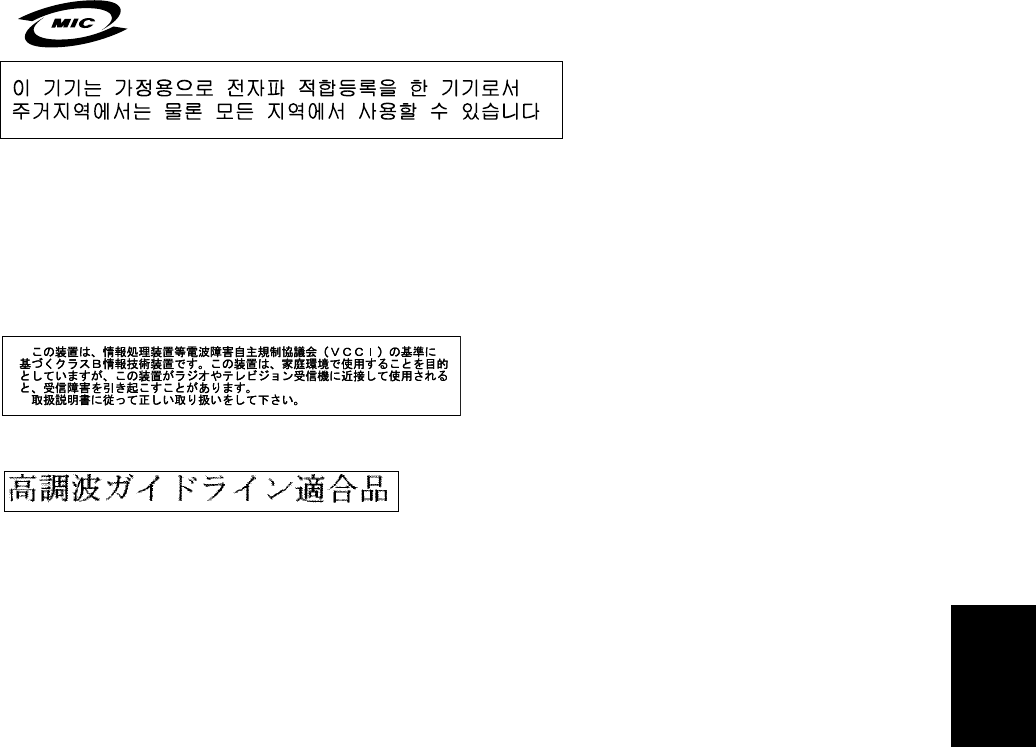
9
APPENDIX
Europeiska unionen (EU)
Denna produkt har testats och följer gränsvärdena för Klass B Information Technology Equipment
enligt CISPR 22 Ú Europeisk standard EN55024:1998. Gränsvärden för Klass B-utrutning utgår frår
vanliga bostadsomräden för att ge ett rimligt skydd mot störningar i kommunikationsenheter.
Korrekt avskärmade och jordade kablar och kontakter måste användas för att minska risken för
störningar i radio- och TV-kommunikationer och annan elektrisk utrustning. Sådana kablar och
kontakter finns tillgängliga hos auktoriserade IBM-återförsäljare.
I enlighet med EN 55024:1998 1992, Performance Criterion A påpekas följande: I närheten av en del
elektromagnetiska fält kan vissa bildstörningar uppstår på skårmen.
Deutsche EMV-Direktive (electromagnetische Verträglichkeit)
Dieses Gerät ist berechtigt in Übereinstimmung mit dem deutschen EMVG vom 9.Nov.92 das EG-
Konformitätszeichen zu führen.
Der Aussteller der Konformitätserklärung ist die IBM UK, Greenock.
Dieses Gerät erfüllt die Bedingungen der EN 55022 Klasse B.
VCCI Class B Notice (Japan Only)
This equipment complies with the limits for a Class B digital device (devices used in or adjacent to a
residential environment) and conforms to the standards for information technology equipment that are
set by the Voluntary Control Council for Interference for preventing radio frequency interference in
residential areas.
Japanese statement of compliance for products less than or equal to 20 A per phase: